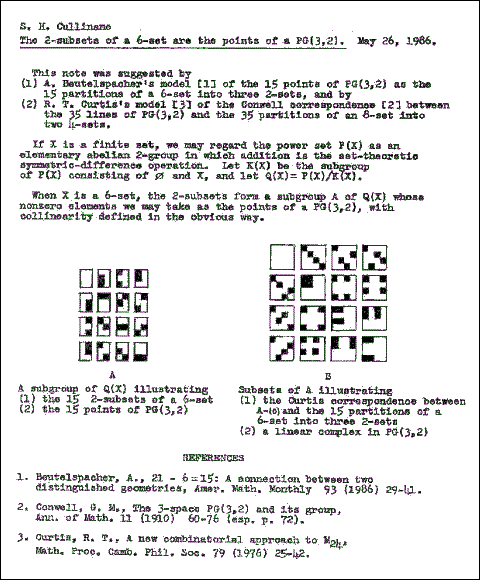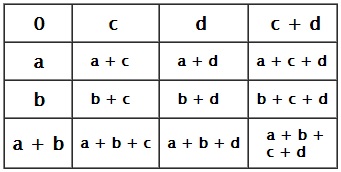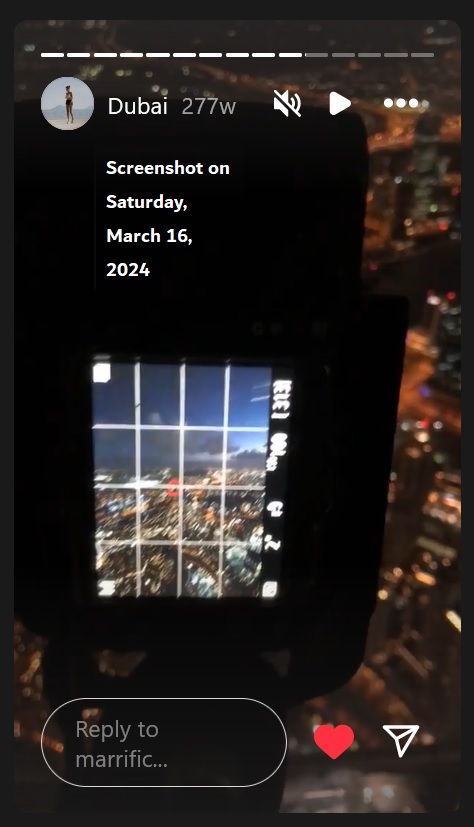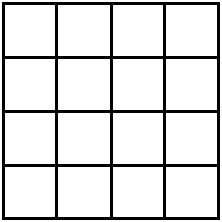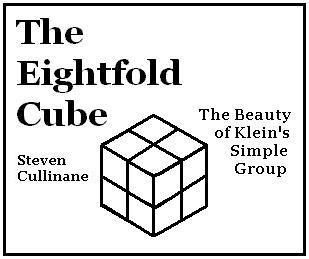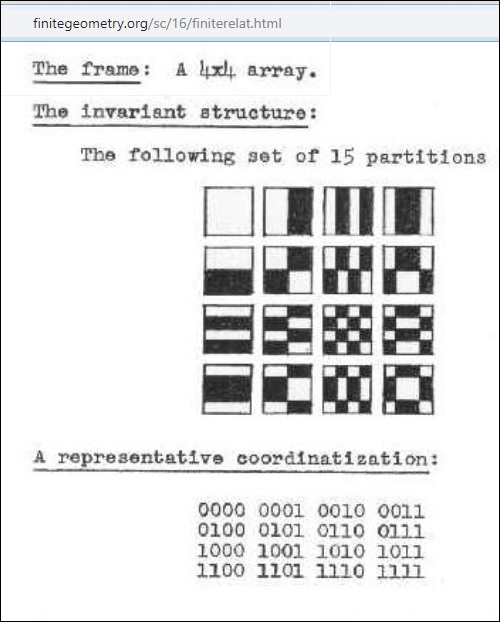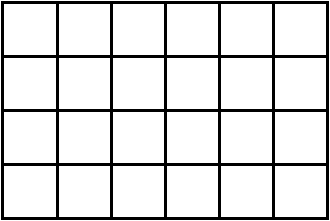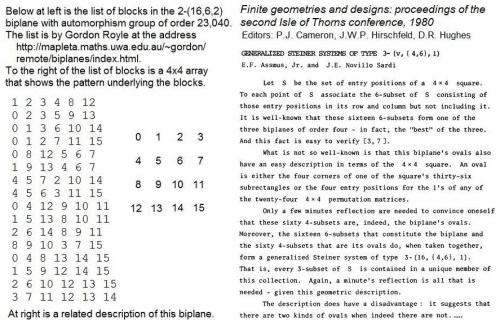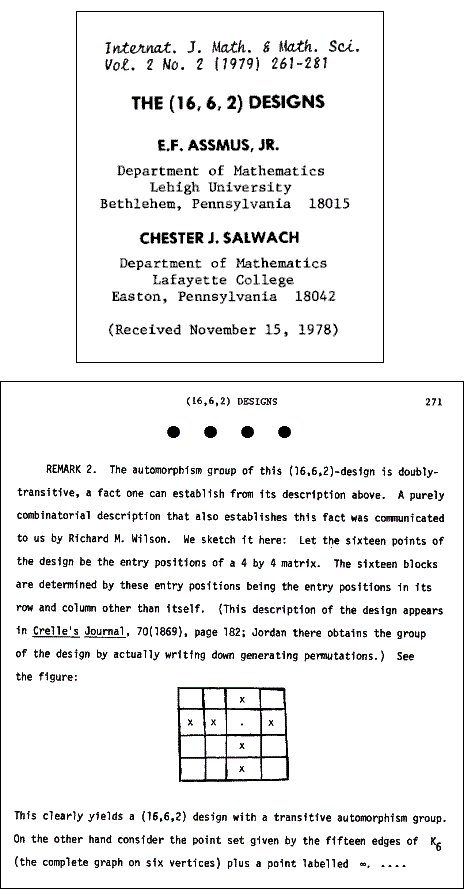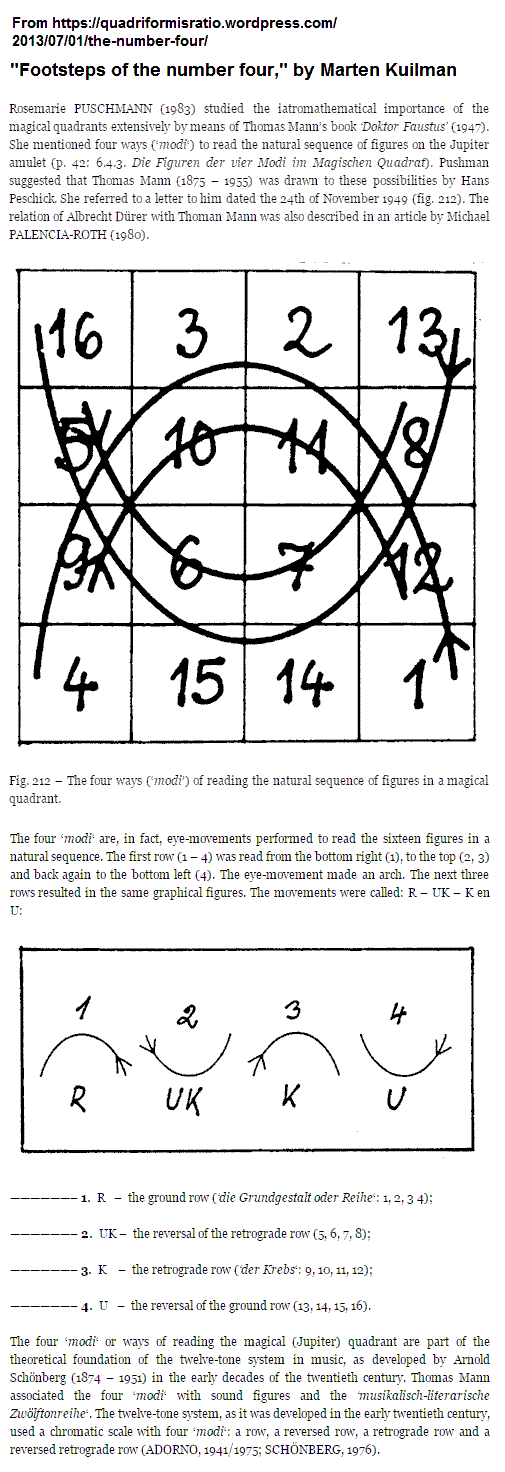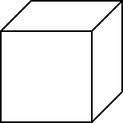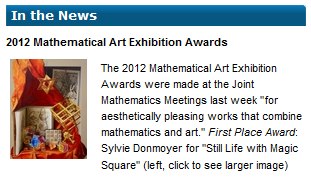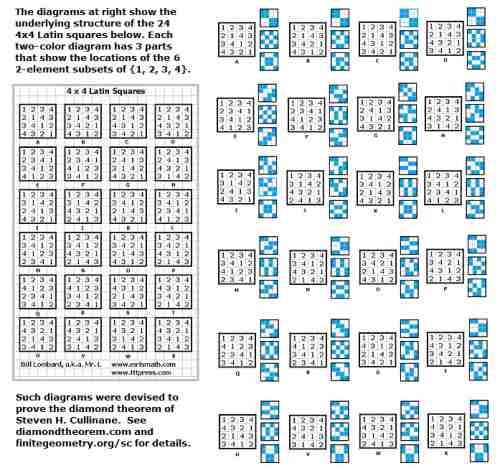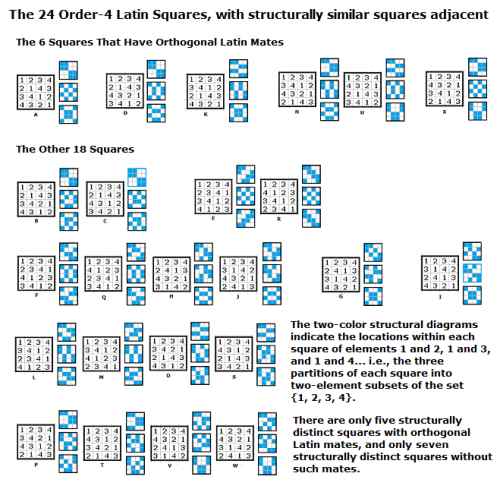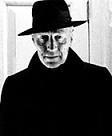Saturday, December 18, 2021
Architecture of the 4×4 Square
Sunday, September 8, 2019
Thursday, February 7, 2019
Geometry of the 4×4 Square: The Kummer Configuration
From the series of posts tagged Kummerhenge —
A Wikipedia article relating the above 4×4 square to the work of Kummer —

A somewhat more interesting aspect of the geometry of the 4×4 square
is its relationship to the 4×6 grid underlying the Miracle Octad Generator
(MOG) of R. T. Curtis. Hudson's 1905 classic Kummer's Quartic Surface
deals with the Kummer properties above and also foreshadows, without
explicitly describing, the finite-geometry properties of the 4×4 square as
a finite affine 4-space — properties that are of use in studying the Mathieu
group M24 with the aid of the MOG.
Tuesday, September 13, 2016
Parametrizing the 4×4 Array
The previous post discussed the parametrization of
the 4×4 array as a vector 4-space over the 2-element
Galois field GF(2).
The 4×4 array may also be parametrized by the symbol
0 along with the fifteen 2-subsets of a 6-set, as in Hudson's
1905 classic Kummer's Quartic Surface —
Hudson in 1905:
These two ways of parametrizing the 4×4 array — as a finite space
and as an array of 2-element sets — were related to one another
by Cullinane in 1986 in describing, in connection with the Curtis
"Miracle Octad Generator," what turned out to be 15 of Hudson's
1905 "Göpel tetrads":
A recap by Cullinane in 2013:
Click images for further details.
Friday, January 17, 2014
The 4×4 Relativity Problem
The sixteen-dot square array in yesterday’s noon post suggests
the following remarks.
“This is the relativity problem: to fix objectively a class of
equivalent coordinatizations and to ascertain the group of
transformations S mediating between them.”
— Hermann Weyl, The Classical Groups ,
Princeton University Press, 1946, p. 16
The Galois tesseract appeared in an early form in the journal
Computer Graphics and Art , Vol. 2, No. 1, February 1977—
The 1977 matrix Q is echoed in the following from 2002—

A different representation of Cullinane’s 1977 square model of the
16-point affine geometry over the two-element Galois field GF(2)
is supplied by Conway and Sloane in Sphere Packings, Lattices and Groups
(first published in 1988) :
Here a, b, c, d are basis vectors in the vector 4-space over GF(2).
(For a 1979 version of this vector space, see AMS Abstract 79T-A37.)
See also a 2011 publication of the Mathematical Association of America —
Tuesday, August 13, 2024
Friday, January 5, 2024
The Pentagram Papers
Sunday, December 17, 2023
Speak, Memory
"Unsocratic Dialogue" with Google DeepMind's Gemini AI continues . . .
|
Do you remember a previous conversation about the question "What is the Cullinane diamond theorem?" If so, how would you answer the question now?
|
Monday, October 16, 2023
Sunday, June 4, 2023
The Galois Core
Monday, October 31, 2022
Folklore vs. Mathematics
Saturday, September 3, 2022
1984 Revisited
Note the three quadruplets of parallel edges in the 1984 figure above.
The above Gates article appeared earlier, in the June 2010 issue of
Physics World , with bigger illustrations. For instance —
Exercise: Describe, without seeing the rest of the article,
the rule used for connecting the balls above.
Wikipedia offers a much clearer picture of a (non-adinkra) tesseract —
And then, more simply, there is the Galois tesseract —
For parts of my own world in June 2010, see this journal for that month.
The above Galois tesseract appears there as follows:
See also the Klein correspondence in a paper from 1968
in yesterday's 2:54 PM ET post.
Tuesday, August 30, 2022
Friday, May 6, 2022
Interality and the Bead Game
WIkipedia on the URL suffix ".io" —
"In computer science, "IO" or "I/O" is commonly used
as an abbreviation for input/output, which makes the
.io domain desirable for services that want to be
associated with technology. .io domains are often used
for open source projects, application programming
interfaces ("APIs"), startup companies, browser games,
and other online services."
An association with the Bead Game from a post of April 7, 2018 —
|
Glasperlenspiel passage quoted here in Summa Mythologica —
“"I suddenly realized that in the language, or at any rate A less poetic meditation on the above 4x4x4 design cube —
"I saw that in the alternation between front and back, See also a related remark by Lévi-Strauss in 1955:
"…three different readings become possible: |
The recent use by a startup company of the URL "interality.io" suggests
a fourth reading for the 1955 list of Lévi-Strauss — in and out —
i.e., inner and outer group automorphisms — from a 2011 post
on the birthday of T. S. Eliot :
A transformation:
Click on the picture for details.
Saturday, March 26, 2022
Box Geometry: Space, Group, Art (Work in Progress)
| Name Tag | .Space | .Group | .Art |
|---|---|---|---|
| Box4 |
2×2 square representing the four-point finite affine geometry AG(2,2). (Box4.space) |
S4 = AGL(2,2) (Box4.group) |
(Box4.art) |
| Box6 |
3×2 (3-row, 2-column) rectangular array representing the elements of an arbitrary 6-set. |
S6 | |
| Box8 | 2x2x2 cube or 4×2 (4-row, 2-column) array. | S8 or A8 or AGL(3,2) of order 1344, or GL(3,2) of order 168 | |
| Box9 | The 3×3 square. | AGL(2,3) or GL(2,3) | |
| Box12 | The 12 edges of a cube, or a 4×3 array for picturing the actions of the Mathieu group M12. | Symmetries of the cube or elements of the group M12 | |
| Box13 | The 13 symmetry axes of the cube. | Symmetries of the cube. | |
| Box15 |
The 15 points of PG(3,2), the projective geometry of 3 dimensions over the 2-element Galois field. |
Collineations of PG(3,2) | |
| Box16 |
The 16 points of AG(4,2), the affine geometry of 4 dimensions over the 2-element Galois field. |
AGL(4,2), the affine group of |
|
| Box20 | The configuration representing Desargues's theorem. | ||
| Box21 | The 21 points and 21 lines of PG(2,4). | ||
| Box24 | The 24 points of the Steiner system S(5, 8, 24). | ||
| Box25 | A 5×5 array representing PG(2,5). | ||
| Box27 |
The 3-dimensional Galois affine space over the 3-element Galois field GF(3). |
||
| Box28 | The 28 bitangents of a plane quartic curve. | ||
| Box32 |
Pair of 4×4 arrays representing orthogonal Latin squares. |
Used to represent elements of AGL(4,2) |
|
| Box35 |
A 5-row-by-7-column array representing the 35 lines in the finite projective space PG(3,2) |
PGL(3,2), order 20,160 | |
| Box36 | Eurler's 36-officer problem. | ||
| Box45 | The 45 Pascal points of the Pascal configuration. | ||
| Box48 | The 48 elements of the group AGL(2,3). | AGL(2,3). | |
| Box56 |
The 56 three-sets within an 8-set or |
||
| Box60 | The Klein configuration. | ||
| Box64 | Solomon's cube. |
— Steven H. Cullinane, March 26-27, 2022
Saturday, May 8, 2021
A Tale of Two Omegas

The Greek capital letter Omega, Ω, is customarily
used to denote a set that is acted upon by a group.
If the group is the affine group of 322,560
transformations of the four-dimensional
affine space over the two-element Galois field,
the appropriate Ω is the 4×4 grid above.
See the Cullinane diamond theorem .
If the group is the large Mathieu group of
244,823,040 permutations of 24 things,
the appropriate Ω is the 4×6 grid below.

See the Miracle Octad Generator of R. T. Curtis.
Thursday, December 3, 2020
Brick Joke
The "bricks" in posts tagged Octad Group suggest some remarks
from last year's HBO "Watchmen" series —
Related material — The two bricks constituting a 4×4 array, and . . .
"(this is the famous Kummer abstract configuration )"
— Igor Dolgachev, ArXiv, 16 October 2019.
As is this —
 .
.
The phrase "octad group" does not, as one might reasonably
suppose, refer to symmetries of an octad (a "brick"), but
instead to symmetries of the above 4×4 array.
A related Broomsday event for the Church of Synchronology —
Sunday, October 18, 2020
Unfolded
See “Unfolded.jpg” in this journal. From that search —
Compare and contrast these figures with images by Wittgenstein in . . .
Related material from last night’s post Modernist Cuts —

Schlick also appears in recent posts tagged Moriarty Variations.
Monday, August 24, 2020
The Mark of Zaentz
Jung's phrase "'four-square' Heavenly City" in the previous post
suggests a geometric object… the 4×4 square —
The "twelve gates" at the sides of the above figure suggest a song —
The Baez date above suggests in turn a review of
the Jan. 4, 2014, post "Heaven's Gate,"
on the death of film producer Saul Zaentz.
Related material —
The "Heavenly City" is perhaps not Cambridge, Massachusetts.
Recall as well Jean Simmons preaching the Foursquare Gospel
in the 1960 film classic "Elmer Gantry" —
Friday, June 12, 2020
Bullshit Studies: “Hyperseeing”
In memoriam —

Friedman co-edited the ISAMA journal Hyperseeing . See also . . .
See too the other articles in Volume 40 of Kybernetes .
Related material —
Compare and contrast the discussion of the geometry
of the 4×4 square in the diamond theorem (1976) with
Nat Friedman’s treatment of the same topic in 2001 —
Wednesday, February 19, 2020
Aitchison’s Octads
The 759 octads of the Steiner system S(5,8,24) are displayed
rather neatly in the Miracle Octad Generator of R. T. Curtis.
A March 9, 2018, construction by Iain Aitchison* pictures the
759 octads on the faces of a cube , with octad elements the
24 edges of a cuboctahedron :
The Curtis octads are related to symmetries of the square.
See my webpage "Geometry of the 4×4 square" from March 2004.
Aitchison's p. 42 slide includes an illustration from that page —

Aitchison's octads are instead related to symmetries of the cube.
Note that essentially the same model as Aitchison's can be pictured
by using, instead of the 24 edges of a cuboctahedron, the 24 outer
faces of subcubes in the eightfold cube .
Image from Christmas Day 2005.
* http://www.math.sci.hiroshima-u.ac.jp/branched/files/2018/
presentations/Aitchison-Hiroshima-2-2018.pdf.
See also Aitchison in this journal.
Monday, February 10, 2020
Notes for Doctor Sleep
Or: Plato's Cave.
See also this journal on November 9, 2003 …
A post on Wittgenstein's "counting pattern" —

Tuesday, October 8, 2019
Kummer at Noon
The Hudson array mentioned above is as follows —
See also Whitehead and the
Relativity Problem (Sept. 22).
For coordinatization of a 4×4
array, see a note from 1986
in the Feb. 26 post Citation.
Monday, June 3, 2019
Jar Story
“. . . Only by the form, the pattern,
Can words or music reach
The stillness, as a Chinese jar still
Moves perpetually in its stillness.”
— T. S. Eliot, Four Quartets
From Writing Chinese Characters:
“It is practical to think of a character centered
within an imaginary square grid . . . .
The grid can… be… subdivided, usually to
9 or 16 squares. . . .“

These “Chinese jars” (as opposed to their contents)
are as follows:
 .
.
See as well Eliot’s 1922 remarks on “extinction of personality”
and the phrase “ego-extinction” in Weyl’s Philosophy of Mathematics —

Thursday, February 28, 2019
Wikipedia Scholarship
Besides omitting the name Cullinane, the anonymous Wikipedia author
also omitted the step of representing the hypercube by a 4×4 array —
an array called in this journal a Galois tesseract.
Tuesday, February 26, 2019
Citation
Some related material in this journal — See a search for k6.gif.
Some related material from Harvard —
Elkies's "15 simple transpositions" clearly correspond to the 15 edges of
the complete graph K6 and to the 15 2-subsets of a 6-set.
For the connection to PG(3,2), see Finite Geometry of the Square and Cube.
The following "manifestation" of the 2-subsets of a 6-set might serve as
the desired Wikipedia citation —
See also the above 1986 construction of PG(3,2) from a 6-set
in the work of other authors in 1994 and 2002 . . .
-
Gonzalez-Dorrego, Maria R. (Maria del Rosario),
(16,6) Configurations and Geometry of Kummer Surfaces in P3.
American Mathematical Society, Providence, RI, 1994. -
Dolgachev, Igor, and Keum, JongHae,
"Birational Automorphisms of Quartic Hessian Surfaces."
Trans. Amer. Math. Soc. 354 (2002), 3031-3057.

Wednesday, December 12, 2018
An Inscape for Douthat
Some images, and a definition, suggested by my remarks here last night
on Apollo and Ross Douthat's remarks today on "The Return of Paganism" —
In finite geometry and combinatorics,
an inscape is a 4×4 array of square figures,
each figure picturing a subset of the overall 4×4 array:

Related material — the phrase
"Quantum Tesseract Theorem" and …
A. An image from the recent
film "A Wrinkle in Time" —

B. A quote from the 1962 book —
"There's something phoney
in the whole setup, Meg thought.
There is definitely something rotten
in the state of Camazotz."
Thursday, November 22, 2018
Rosenhain and Göpel Meet Kummer in Projective 3-Space
For further details, see finitegeometry.org/sc/35/hudson.html.
Geometric Incarnation
"The hint half guessed, the gift half understood, is Incarnation."
— T. S. Eliot in Four Quartets
Note also the four 4×4 arrays surrounding the central diamond
in the chi of the chi-rho page of the Book of Kells —
From a Log24 post
of March 17, 2012
"Interlocking, interlacing, interweaving"
— Condensed version of page 141 in Eddington's
1939 Philosophy of Physical Science
Thursday, November 8, 2018
Geometry Lesson
From "The Trials of Device" (April 24, 2017) —
See also Wittgenstein in a search for "Ein Kampf " in this journal.
Saturday, July 14, 2018
Expanding the Spiel
The walkerart.org passage above is from Feb. 17, 2011.
See also this journal on Feb. 17, 2011 —
"… Only by the form, the pattern,
Can words or music reach
The stillness…."
— T. S. Eliot,
Four Quartets

For further details, see Time Fold.
Thursday, July 5, 2018
Paz:
Some context for what Heidegger called
das Spiegel-Spiel des Gevierts
From Helen Lane's translation of El Mono Gramático ,
a book by Nobel winner Octavio Paz first published
in Barcelona by Seix Barral in 1974 —
|
Simultaneous perspective does not look upon language as a path because it is not the search for meaning that orients it. Poetry does not attempt to discover what there is at the end of the road; it conceives of the text as a series of transparent strata within which the various parts—the different verbal and semantic currents—produce momentary configurations as they intertwine or break apart, as they reflect each other or efface each other. Poetry contemplates itself, fuses with itself, and obliterates itself in the crystallizations of language. Apparitions, metamorphoses, volatilizations, precipitations of presences. These configurations are crystallized time: although they are perpetually in motion, they always point to the same hour—the hour of change. Each one of them contains all the others, each one is inside the others: change is only the oft-repeated and ever-different metaphor of identity.
— Paz, Octavio. The Monkey Grammarian |
A related 1960 meditation from Claude Lévi-Strauss taken from a
Log24 post of St. Andrew's Day 2017, "The Matrix for Quantum Mystics":

"In Vol. I of Structural Anthropology , p. 209, I have shown that
this analysis alone can account for the double aspect of time
representation in all mythical systems: the narrative is both
'in time' (it consists of a succession of events) and 'beyond'
(its value is permanent)." — Claude Lévi-Strauss
I prefer the earlier, better-known, remarks on time by T. S. Eliot
in Four Quartets , and the following four quartets
(from The Matrix Meets the Grid) —
Saturday, February 24, 2018
The Ugly Duck
"What of the night
That lights and dims the stars?
Do you know, Hans Christian,
Now that you see the night?"
— The concluding lines of
"Sonatina to Hans Christian,"
by Wallace Stevens
(in Harmonium (second edition, 1931))
From "Mathmagic Land" (May 22, 2015)
Donald in Mathmagic Land
From "The Trials of Device" (April 24, 2017)
Saturday, February 17, 2018
The Binary Revolution
Michael Atiyah on the late Ron Shaw —

Phrases by Atiyah related to the importance in mathematics
of the two-element Galois field GF(2) —
- “The digital revolution based on the 2 symbols (0,1)”
- “The algebra of George Boole”
- “Binary codes”
- “Dirac’s spinors, with their up/down dichotomy”
These phrases are from the year-end review of Trinity College,
Cambridge, Trinity Annual Record 2017 .
I prefer other, purely geometric, reasons for the importance of GF(2) —
- The 2×2 square
- The 2x2x2 cube
- The 4×4 square
- The 4x4x4 cube
See Finite Geometry of the Square and Cube.
See also today’s earlier post God’s Dice and Atiyah on the theology of
(Boolean) algebra vs. (Galois) geometry:

Friday, February 16, 2018
Two Kinds of Symmetry
The Institute for Advanced Study (IAS) at Princeton in its Fall 2015 Letter
revived "Beautiful Mathematics" as a title:
This ugly phrase was earlier used by Truman State University
professor Martin Erickson as a book title. See below.
In the same IAS Fall 2015 Letter appear the following remarks
by Freeman Dyson —
". . . a special case of a much deeper connection that Ian Macdonald
discovered between two kinds of symmetry which we call modular and affine.
The two kinds of symmetry were originally found in separate parts of science,
modular in pure mathematics and affine in physics. Modular symmetry is
displayed for everyone to see in the drawings of flying angels and devils
by the artist Maurits Escher. Escher understood the mathematics and got the
details right. Affine symmetry is displayed in the peculiar groupings of particles
created by physicists with high-energy accelerators. The mathematician
Robert Langlands was the first to conjecture a connection between these and
other kinds of symmetry. . . ." (Wikipedia link added.)
The adjective "modular" might aptly be applied to . . .

The adjective "affine" might aptly be applied to . . .
The geometry of the 4×4 square combines modular symmetry
(i.e., related to theta functions) with the affine symmetry above.
Hudson's 1905 discussion of modular symmetry (that of Rosenhain
tetrads and Göpel tetrads) in the 4×4 square used a parametrization
of that square by the digit 0 and the fifteen 2-subsets of a 6-set, but
did not discuss the 4×4 square as an affine space.
For the connection of the 15 Kummer modular 2-subsets with the 16-
element affine space over the two-element Galois field GF(2), see my note
of May 26, 1986, "The 2-subsets of a 6-set are the points of a PG(3,2)" —
— and the affine structure in the 1979 AMS abstract
"Symmetry invariance in a diamond ring" —
For some historical background on the symmetry investigations by
Dyson and Macdonald, see Dyson's 1972 article "MIssed Opportunities."
For Macdonald's own use of the words "modular" and "affine," see
Macdonald, I. G., "Affine Lie algebras and modular forms,"
Séminaire N. Bourbaki , Vol. 23 (1980-1981), Talk no. 577, pp. 258-276.
Friday, December 1, 2017
The Architect and the Matrix
In memory of Yale art historian Vincent Scully, who reportedly
died at 97 last night at his home in Lynchburg, Va., some remarks
from the firm of architect John Outram and from Scully —
Update from the morning of December 2 —
The above 3×3 figure is of course not unrelated to
the 4×4 figure in The Matrix for Quantum Mystics:
 .
.
See as well Tsimtsum in this journal.
Thursday, November 30, 2017
The Matrix for Quantum Mystics
Scholia on the title — See Quantum + Mystic in this journal.


"In Vol. I of Structural Anthropology , p. 209, I have shown that
this analysis alone can account for the double aspect of time
representation in all mythical systems: the narrative is both
'in time' (it consists of a succession of events) and 'beyond'
(its value is permanent)." — Claude Lévi-Strauss, 1976
I prefer the earlier, better-known, remarks on time by T. S. Eliot
in Four Quartets , and the following four quartets (from
The Matrix Meets the Grid) —
From a Log24 post of June 26-27, 2017:
A work of Eddington cited in 1974 by von Franz —

See also Dirac and Geometry and Kummer in this journal.
Ron Shaw on Eddington's triads "associated in conjugate pairs" —
For more about hyperbolic and isotropic lines in PG(3,2),
see posts tagged Diamond Theorem Correlation.
For Shaw, in memoriam — See Contrapuntal Interweaving and The Fugue.
Friday, November 24, 2017
The Matrix Meets the Grid
The Matrix —
The Grid —
Picturing the Witt Construction —
"Read something that means something." — New Yorker ad
Saturday, October 14, 2017
Tuesday, September 5, 2017
Florence 2001
Or: Coordinatization for Physicists
This post was suggested by the link on the word "coordinatized"
in the previous post.


I regret that Weyl's term "coordinatization" perhaps has
too many syllables for the readers of recreational mathematics —
for example, of an article on 4×4 magic squares by Conway, Norton,
and Ryba to be published today by Princeton University Press.
Insight into the deeper properties of such squares unfortunately
requires both the ability to learn what a "Galois field" is and the
ability to comprehend seven-syllable words.
Sunday, September 3, 2017
Broomsday Revisited
Ivars Peterson in 2000 on a sort of conceptual art —
" Brill has tried out a variety of grid-scrambling transformations
to see what happens. Aesthetic sensibilities govern which
transformation to use, what size the rectangular grid should be,
and which iteration to look at, he says. 'Once a fruitful
transformation, rectangle size, and iteration number have been
found, the artist is in a position to create compelling imagery.' "
— "Scrambled Grids," August 28, 2000
Or not.
If aesthetic sensibilities lead to a 23-cycle on a 4×6 grid, the results
may not be pretty —
From "Geometry of the 4×4 Square."
See a Log24 post, Noncontinuous Groups, on Broomsday 2009.
Saturday, September 2, 2017
A Touchstone
This post was suggested by the names* (if not the very abstruse
concepts ) in the Aug. 20, 2013, preprint "A Panoramic Overview
of Inter-universal Teichmuller Theory," by S. Mochizuki.
* Specifically, Jacobi and Kummer (along with theta functions).
I do not know of any direct connection between these names'
relevance to the writings of Mochizuki and their relevance
(via Hudson, 1905) to my own much more elementary studies of
the geometry of the 4×4 square.
Friday, July 14, 2017
March 26, 2006 (continued)
The above image, posted here on March 26, 2006, was
suggested by this morning's post "Black Art" and by another
item from that date in 2006 —
Thursday, July 6, 2017
A Pleasing Situation
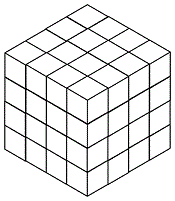
The 4x4x4 cube is the natural setting
for the finite version of the Klein quadric
and the eight "heptads" discussed by
Conwell in 1910.
As R. Shaw remarked in 1995,
"The situation is indeed quite pleasing."

Tuesday, May 23, 2017
Saturday, May 20, 2017
van Lint and Wilson Meet the Galois Tesseract*
Click image to enlarge.
The above 35 projective lines, within a 4×4 array —
The above 15 projective planes, within a 4×4 array (in white) —

* See Galois Tesseract in this journal.
Wednesday, April 26, 2017
A Tale Unfolded
A sketch, adapted tonight from Girl Scouts of Palo Alto —

From the April 14 noon post High Concept —

From the April 14 3 AM post Hudson and Finite Geometry —
From the April 24 evening post The Trials of Device —
Note that Hudson’s 1905 “unfolding” of even and odd puts even on top of
the square array, but my own 2013 unfolding above puts even at its left.
Monday, April 24, 2017
The Trials of Device
"A blank underlies the trials of device"
— Wallace Stevens, "An Ordinary Evening in New Haven" (1950)
A possible meaning for the phrase "the trials of device" —
See also Log24 posts mentioning a particular device, the pentagram .
For instance —
Friday, April 14, 2017
Hudson and Finite Geometry
The above four-element sets of black subsquares of a 4×4 square array
are 15 of the 60 Göpel tetrads , and 20 of the 80 Rosenhain tetrads , defined
by R. W. H. T. Hudson in his 1905 classic Kummer's Quartic Surface .
Hudson did not view these 35 tetrads as planes through the origin in a finite
affine 4-space (or, equivalently, as lines in the corresponding finite projective
3-space).
In order to view them in this way, one can view the tetrads as derived,
via the 15 two-element subsets of a six-element set, from the 16 elements
of the binary Galois affine space pictured above at top left.
This space is formed by taking symmetric-difference (Galois binary)
sums of the 15 two-element subsets, and identifying any resulting four-
element (or, summing three disjoint two-element subsets, six-element)
subsets with their complements. This process was described in my note
"The 2-subsets of a 6-set are the points of a PG(3,2)" of May 26, 1986.
The space was later described in the following —

Monday, April 3, 2017
Monday, February 20, 2017
Mathematics and Narrative
Mathematics —
Hudson's parametrization of the
4×4 square, published in 1905:
A later parametrization, from this date in 1986:
A note from later in 1986 shows the equivalence of these
two parametrizations:
Narrative —
Posts tagged Memory-History-Geometry.
The mathematically challenged may prefer the narrative of the
Creation Matrix from the religion of the Transformers:
"According to religious legend, the core of the Matrix
was created from Solomus, the god of wisdom,
trapped in the form of a crystal by Mortilus, the god
of death. Following the defeat of Mortilus, Solomus
managed to transform his crystal prison into the Matrix—
a conduit for the energies of Primus, who had himself
transformed into the life-giving computer Vector Sigma."
Wednesday, January 4, 2017
A Drama of Many Forms
According to art historian Rosalind Krauss in 1979,
the grid's earliest employers
"can be seen to be participating in a drama
that extended well beyond the domain of art.
That drama, which took many forms, was staged
in many places. One of them was a courtroom,
where early in this century, science did battle with God,
and, reversing all earlier precedents, won."
The previous post discussed the 3×3 grid in the context of
Krauss's drama. In memory of T. S. Eliot, who died on this date
in 1965, an image of the next-largest square grid, the 4×4 array:

See instances of the above image.
Friday, November 25, 2016
Priority
Before the monograph "Diamond Theory" was distributed in 1976,
two (at least) notable figures were published that illustrate
symmetry properties of the 4×4 square:
Hudson in 1905 —
Golomb in 1967 —

It is also likely that some figures illustrating Walsh functions as
two-color square arrays were published prior to 1976.
Update of Dec. 7, 2016 —
The earlier 1950's diagrams of Veitch and Karnaugh used the
1's and 0's of Boole, not those of Galois.
Tuesday, October 18, 2016
Parametrization
The term "parametrization," as discussed in Wikipedia,
seems useful for describing labelings that are not, at least
at first glance, of a vector-space nature.
Examples: The labelings of a 4×4 array by a blank space
plus the 15 two-subsets of a six-set (Hudson, 1905) or by a
blank plus the 5 elements and the 10 two-subsets of a five-set
(derived in 2014 from a 1906 page by Whitehead), or by
a blank plus the 15 line diagrams of the diamond theorem.
Thus "parametrization" is apparently more general than
the word "coodinatization" used by Hermann Weyl —
“This is the relativity problem: to fix objectively
a class of equivalent coordinatizations and to
ascertain the group of transformations S
mediating between them.”
— Hermann Weyl, The Classical Groups ,
Princeton University Press, 1946, p. 16
Note, however, that Weyl's definition of "coordinatization"
is not limited to vector-space coordinates. He describes it
as simply a mapping to a set of reproducible symbols .
(But Weyl does imply that these symbols should, like vector-space
coordinates, admit a group of transformations among themselves
that can be used to describe transformations of the point-space
being coordinatized.)
Friday, September 16, 2016
A Counting-Pattern
Monday, September 12, 2016
The Kummer Lattice
The previous post quoted Tom Wolfe on Chomsky's use of
the word "array."
An example of particular interest is the 4×4 array
(whether of dots or of unit squares) —
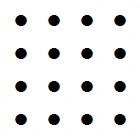
 .
.
Some context for the 4×4 array —
The following definition indicates that the 4×4 array, when
suitably coordinatized, underlies the Kummer lattice .

Further background on the Kummer lattice:
Alice Garbagnati and Alessandra Sarti,
"Kummer Surfaces and K3 surfaces
with $(Z/2Z)^4$ symplectic action."
To appear in Rocky Mountain J. Math. —
The above article is written from the viewpoint of traditional
algebraic geometry. For a less traditional view of the underlying
affine 4-space from finite geometry, see the website
Finite Geometry of the Square and Cube.
Some further context …
"To our knowledge, the relation of the Golay code
to the Kummer lattice … is a new observation."
— Anne Taormina and Katrin Wendland,
"The overarching finite symmetry group of
Kummer surfaces in the Mathieu group M24 "
As noted earlier, Taormina and Wendland seem not to be aware of
R. W. H. T. Hudson's use of the (uncoordinatized*) 4×4 array in his
1905 book Kummer's Quartic Surface. The array was coordinatized,
i.e. given a "vector space structure," by Cullinane eight years prior to
the cited remarks of Curtis.
* Update of Sept. 14: "Uncoordinatized," but parametrized by 0 and
the 15 two-subsets of a six-set. See the post of Sept. 13.
Thursday, July 28, 2016
Tuesday, June 7, 2016
Wednesday, May 25, 2016
Framework
"Studies of spin-½ theories in the framework of projective geometry
have been undertaken before." — Y. Jack Ng and H. van Dam,
February 20, 2009
For one such framework,* see posts from that same date
four years earlier — February 20, 2005.
* A 4×4 array. See the 1977, 1978, and 1986 versions by
Steven H. Cullinane, the 1987 version by R. T. Curtis, and
the 1988 Conway-Sloane version illustrated below —
Cullinane, 1977
Cullinane, 1978
Cullinane, 1986

Curtis, 1987

Update of 10:42 PM ET on Sunday, June 19, 2016 —
The above images are precursors to …
Conway and Sloane, 1988

Update of 10 AM ET Sept. 16, 2016 — The excerpt from the
1977 "Diamond Theory" article was added above.
Kummer and Dirac
From "Projective Geometry and PT-Symmetric Dirac Hamiltonian,"
Y. Jack Ng and H. van Dam,
Physics Letters B , Volume 673, Issue 3,
23 March 2009, Pages 237–239
(http://arxiv.org/abs/0901.2579v2, last revised Feb. 20, 2009)
" Studies of spin-½ theories in the framework of projective geometry
have been undertaken before. See, e.g., Ref. [4]. 1 "
" 1 These papers are rather mathematical and technical.
The authors of the first two papers discuss the Dirac equation
in terms of the Plucker-Klein correspondence between lines of
a three-dimensional projective space and points of a quadric
in a five-dimensional projective space. The last paper shows
that the Dirac equation bears a certain relation to Kummer’s
surface, viz., the structure of the Dirac ring of matrices is
related to that of Kummer’s 166 configuration . . . ."
[4]
O. Veblen
Proc. Natl. Acad. Sci. USA , 19 (1933), p. 503
Full Text via CrossRef
E.M. Bruins
Proc. Nederl. Akad. Wetensch. , 52 (1949), p. 1135
F.C. Taylor Jr., Master thesis, University of North Carolina
at Chapel Hill (1968), unpublished
A remark of my own on the structure of Kummer’s 166 configuration . . . .
See as well yesterday morning's post.
Monday, May 2, 2016
Subjective Quality
The previous post deals in part with a figure from the 1988 book
Sphere Packings, Lattices and Groups , by J. H. Conway and
N. J. A. Sloane.
Siobhan Roberts recently wrote a book about the first of these
authors, Conway. I just discovered that last fall she also had an
article about the second author, Sloane, published:
"How to Build a Search Engine for Mathematics,"
Nautilus , Oct 22, 2015.
Meanwhile, in this journal …
Log24 on that same date, Oct. 22, 2015 —
Roberts's remarks on Conway and later on Sloane are perhaps
examples of subjective quality, as opposed to the objective quality
sought, if not found, by Alexander, and exemplified by the
above bijection discussed here last October.
Sunday, May 1, 2016
Sunday Appetizer from 1984
Judith Shulevitz in The New York Times
on Sunday, July 18, 2010
(quoted here Aug. 15, 2010) —
“What would an organic Christian Sabbath look like today?”

The 2015 German edition of Beautiful Mathematics ,
a 2011 Mathematical Association of America (MAA) book,
was retitled Mathematische Appetithäppchen —
Mathematical Appetizers . The German edition mentions
the author's source, omitted in the original American edition,
for his section 5.17, "A Group of Operations" (in German,
5.17, "Eine Gruppe von Operationen") —
|
Mathematische Appetithäppchen: Autor: Erickson, Martin —
"Weitere Informationen zu diesem Themenkreis finden sich |
That source was a document that has been on the Web
since 2002. The document was submitted to the MAA
in 1984 but was rejected. The German edition omits the
document's title, and describes it as merely a source for
"further information on this subject area."
The title of the document, "Binary Coordinate Systems,"
is highly relevant to figure 11.16c on page 312 of a book
published four years after the document was written: the
1988 first edition of Sphere Packings, Lattices and Groups ,
by J. H. Conway and N. J. A. Sloane —

A passage from the 1984 document —
Monday, April 25, 2016
Seven Seals
An old version of the Wikipedia article "Group theory"
(pictured in the previous post) —

"More poetically …"
From Hermann Weyl's 1952 classic Symmetry —
"Galois' ideas, which for several decades remained
a book with seven seals but later exerted a more
and more profound influence upon the whole
development of mathematics, are contained in
a farewell letter written to a friend on the eve of
his death, which he met in a silly duel at the age of
twenty-one. This letter, if judged by the novelty and
profundity of ideas it contains, is perhaps the most
substantial piece of writing in the whole literature
of mankind."
The seven seals from the previous post, with some context —
These models of projective points are drawn from the underlying
structure described (in the 4×4 case) as part of the proof of the
Cullinane diamond theorem .
Friday, August 7, 2015
Parts
Spielerei —
"On the most recent visit, Arthur had given him
a brightly colored cube, with sides you could twist
in all directions, a new toy that had just come onto
the market."
— Daniel Kehlmann, F: A Novel (2014),
translated from the German by
Carol Brown Janeway
Nicht Spielerei —

A figure from this journal at 2 AM ET
on Monday, August 3, 2015
Also on August 3 —
FRANKFURT — "Johanna Quandt, the matriarch of the family
that controls the automaker BMW and one of the wealthiest
people in Germany, died on Monday in Bad Homburg, Germany.
She was 89."
MANHATTAN — "Carol Brown Janeway, a Scottish-born
publishing executive, editor and award-winning translator who
introduced American readers to dozens of international authors,
died on Monday in Manhattan. She was 71."
Related material — Heisenberg on beauty, Munich, 1970
Monday, August 3, 2015
Text and Context*
"The ORCID organization offers an open and
independent registry intended to be the de facto
standard for contributor identification in research
and academic publishing. On 16 October 2012,
ORCID launched its registry services… and
started issuing user identifiers." — Wikipedia
This journal on the above date —
A more recent identifier —
Related material —
See also the recent posts Ein Kampf and Symplectic.
* Continued.
Wednesday, June 17, 2015
Slow Art, Continued
The title of the previous post, "Slow Art," is a phrase
of the late art critic Robert Hughes.
Example from mathematics:
-
Göpel tetrads as subsets of a 4×4 square in the classic
1905 book Kummer's Quartic Surface by R. W. H. T. Hudson.
These subsets were constructed as helpful schematic diagrams,
without any reference to the concept of finite geometry they
were later to embody.
-
Göpel tetrads (not named as such), again as subsets of
a 4×4 square, that form the 15 isotropic projective lines of the
finite projective 3-space PG(3,2) in a note on finite geometry
from 1986 —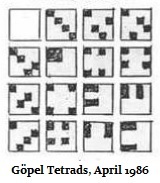
-
Göpel tetrads as these figures of finite geometry in a 1990
foreword to the reissued 1905 book of Hudson:
Click the Barth passage to see it with its surrounding text.
Related material:
Monday, June 15, 2015
Omega Matrix
See that phrase in this journal.
See also last night's post.

The Greek letter Ω is customarily used to
denote a set that is acted upon by a group.
If the group is the affine group of 322,560
transformations of the four-dimensional
affine space over the two-element Galois
field, the appropriate Ω is the 4×4 grid above.
Saturday, April 4, 2015
Harrowing of Hell (continued)
Holy Saturday is, according to tradition, the day of
the harrowing of Hell.
Notes:
The above passage on "Die Figuren der vier Modi
im Magischen Quadrat " should be read in the context of
a Log24 post from last year's Devil's Night (the night of
October 30-31). The post, "Structure," indicates that, using
the transformations of the diamond theorem, the notorious
"magic" square of Albrecht Dürer may be transformed
into normal reading order. That order is only one of
322,560 natural reading orders for any 4×4 array of
symbols. The above four "modi" describe another.
Monday, March 23, 2015
Gallucci’s Möbius Configuration
From H. S. M. Coxeter's 1950 paper
"Self-Dual Configurations and Regular Graphs,"
a 4×4 array and a more perspicuous rearrangement—
(Click image to enlarge.)
The above rearrangement brings Coxeter's remarks into accord
with the webpage The Galois Tesseract.
Update of Thursday, March 26, 2015 —
For an explanation of Coxeter's Fig. 24, see Thursday's later
post titled "The Möbius Hypercube."
Wednesday, January 14, 2015
Serial Box
Enotes.com on Herman Wouk's 1985 novel Inside, Outside :
"The 'outside' of the title is the goyish world
into which David’s profession has drawn him;
the 'inside' is the warm life of his Russian-
Jewish family on which he, as narrator, reflects
in the course of the novel."
For a different sort of 'inside' life, see this morning's post
Gesamtkunstwerk , and Nathan Shields's Feb. 8, 2011,
tribute to a serial composer "In Memoriam, Milton Babbitt."
Some other context for Shields's musical remarks —
Doctor Faustus and Dürer Square.
For a more interesting contrast of inside with outside
that has nothing to do with ethnicity, see the Feb. 10,
2014, post Mystery Box III: Inside, Outside, about
the following box:
 .
.
Sunday, September 21, 2014
Sermon
The previous post discussed the anatomy of the sum 9 + 6.
A different approach: “A” and “The 6 spreads in A” below —
Tuesday, September 9, 2014
Smoke and Mirrors
This post is continued from a March 12, 2013, post titled
"Smoke and Mirrors" on art in Tromsø, Norway, and from
a June 22, 2014, post on the nineteenth-century
mathematicians Rosenhain and Göpel.
The latter day was the day of death for
mathematician Loren D. Olson, Harvard '64.
For some background on that June 22 post, see the tag
Rosenhain and Göpel in this journal.
Some background on Olson, who taught at the
University of Tromsø, from the American Mathematical
Society yesterday:
Olson died not long after attending the 50th reunion of the
Harvard Class of 1964.
For another connection between that class (also my own)
and Tromsø, see posts tagged "Elegantly Packaged."
This phrase was taken from today's (print)
New York Times review of a new play titled "Smoke."
The phrase refers here to the following "package" for
some mathematical objects that were named after
Rosenhain and Göpel — a 4×4 array —
For the way these objects were packaged within the array
in 1905 by British mathematician R. W. H. T. Hudson, see
a page at finitegometry.org/sc. For the connection to the art
in Tromsø mentioned above, see the diamond theorem.
Monday, August 4, 2014
A Wrinkle in Space
"There is such a thing as a tesseract." — Madeleine L'Engle
An approach via the Omega Matrix:
See, too, Rosenhain and Göpel as The Shadow Guests .
Wednesday, May 21, 2014
The Tetrahedral Model of PG(3,2)
The page of Whitehead linked to this morning
suggests a review of Polster's tetrahedral model
of the finite projective 3-space PG(3,2) over the
two-element Galois field GF(2).


|
The above passage from Whitehead's 1906 book suggests
that the tetrahedral model may be older than Polster thinks.
Shown at right below is a correspondence between Whitehead's
version of the tetrahedral model and my own square model,
based on the 4×4 array I call the Galois tesseract (at left below).
(Click to enlarge.)
Friday, March 21, 2014
Three Constructions of the Miracle Octad Generator
See also a Log24 post on this subject from Dec. 14, 2013,
especially (scroll down) the update of March 9, 2014.
Related material on the Turyn-Curtis construction
from the University of Cambridge —

— Slide by "Dr. Parker" — Apparently Richard A. Parker —
Lecture 4, "Discovering M24," in slides for lectures 1-8 from lectures
at Cambridge in 2010-2011 on "Sporadic and Related Groups."
See also the Parker lectures of 2012-2013 on the same topic.
A third construction of Curtis's 35 4×6 1976 MOG arrays would use
Cullinane's analysis of the 4×4 subarrays' affine and projective structure,
and point out the fact that Conwell's 1910 correspondence of the 35
4+4-partitions of an 8-set with the 35 lines of the projective 3-space
over the 2-element field, PG(3, 2), is essentially the same correspondence
as that constituting Curtis's 1976 MOG.
See The Diamond Theorem, Finite Relativity, Galois Space,
Generating the Octad Generator, and The Klein Correspondence.
Update of March 22-March 23 —
Adding together as (0,1)-matrices over GF(2) the black parts (black
squares as 1's, all other squares as 0's) of the 35 4×6 arrays of the 1976
Curtis MOG would then reveal* the symmetric role played in octads
by what Curtis called the heavy brick , and so reveal also the action of
S3 on the three Curtis bricks that leaves invariant the set of all 759
octads of the S(5, 8, 24) constructed from the 35 MOG arrays. For more
details of this "by-hand" construction, see Geometry of the 4×4 Square.
For the mathematical properties of the S(5, 8, 24), it is convenient to
have a separate construction (such as Turyn's), not by hand, of the
extended binary Golay code. See the Brouwer preprint quoted above.
* "Then a miracle occurs," as in the classic 1977 Sidney Harris cartoon.
Illustration of array addition from March 23 —
Monday, February 10, 2014
Mystery Box III: Inside, Outside
(Continued from Mystery Box, Feb. 4, and Mystery Box II, Feb. 5.)
The Box

Inside the Box
Outside the Box
For the connection of the inside notation to the outside geometry,
see Desargues via Galois.
(For a related connection to curves and surfaces in the outside
geometry, see Hudson's classic Kummer's Quartic Surface and
Rosenhain and Göpel Tetrads in PG(3,2).)
Saturday, January 18, 2014
The Triangle Relativity Problem
A sequel to last night's post The 4×4 Relativity Problem —
In other words, how should the triangle corresponding to
the above square be coordinatized ?
See also a post of July 8, 2012 — "Not Quite Obvious."
Context — "Triangles Are Square," a webpage stemming
from an American Mathematical Monthly item published
in 1984.
Thursday, January 16, 2014
Confession of a Sucker
Today’s 11 AM (ET) post was suggested by a New York Times
article, online yesterday, about art gallery owner Lisa Cooley.
A check of Cooley’s website yields the image below,
related to Beckett’s Molloy .
For the relevant passage from Molloy , click the following:
“I took advantage of being at the seaside
to lay in a store of sucking-stones.“
For posts on Molloy in this journal, click Beckett + Molloy .
Cynthia Daignault, 2011:
The one I shall now describe, if I can…
Oil on linen, in 2 parts: 40 x 30 inches, 96 x 75 inches
Related art theory —
Monday, October 28, 2013
Stella’s Goal
The Whitney Museum of American Art has stated
that artist Frank Stella in 1959
"wanted to create work that was methodical,
intellectual and passionless."
Source: Whitney Museum, transcript of audio guide.
Related material:
A figure from this journal on July 13, 2003…

… and some properties of that figure.
Sunday, September 22, 2013
Incarnation, Part 2
"… a list of group theoretic invariants
and their geometric incarnation…"
— David Lehavi on the Kummer 166 configuration in 2007
Related material —
"The hint half guessed, the gift half understood, is Incarnation."
— T. S. Eliot in Four Quartets
"This is not theology; this is mathematics."
— Steven H. Cullinane on four quartets
To wit:
Saturday, September 21, 2013
Geometric Incarnation
The Kummer 166 configuration is the configuration of sixteen
6-sets within a 4×4 square array of points in which each 6-set
is determined by one of the 16 points of the array and
consists of the 3 other points in that point's row and the
3 other points in that point's column.
See Configurations and Squares.
The Wikipedia article Kummer surface uses a rather poetic
phrase* to describe the relationship of the 166 to a number
of other mathematical concepts — "geometric incarnation."
Related material from finitegeometry.org —
* Apparently from David Lehavi on March 18, 2007, at Citizendium .
Thursday, September 5, 2013
Tuesday, July 16, 2013
Child Buyers
The title refers to a classic 1960 novel by John Hersey.
“How do you get young people excited about space?”
— Megan Garber in The Atlantic , Aug. 16, 2012
(Italics added.) (See previous four posts.)
Allyn Jackson on “Simplicity, in Mathematics and in Art,”
in the new August 2013 issue of Notices of the American
Mathematical Society—
“As conventions evolve, so do notions of simplicity.
Franks mentioned Gauss’s 1831 paper that
established the respectability of complex numbers.”
This suggests a related image by Gauss, with a
remark on simplicity—
Here Gauss’s diagram is not, as may appear at first glance,
a 3×3 array of squares, but is rather a 4×4 array of discrete
points (part of an infinite plane array).
Related material that does feature the somewhat simpler 3×3 array
of squares, not seen as part of an infinite array—
Marketing the Holy Field
Click image for the original post.
For a purely mathematical view of the holy field, see Visualizing GL(2,p).
Wednesday, June 19, 2013
Ein Eck
"Da hats ein Eck" —
"you've/she's (etc.) got problems there"
St. Galluskirche:
St. Gallus's Day, 2012:
Click image for a St. Gallus's Day post.
A related problem:
Discuss the structure of the 4x4x4 "magic" cube
sent by Pierre de Fermat to Father Marin Mersenne
on April 1, 1640, in light of the above post.
Thursday, June 13, 2013
Gate
"Eight is a Gate." — Mnemonic rhyme
Today's previous post, Window, showed a version
of the Chinese character for "field"—
This suggests a related image—
The related image in turn suggests…
Unlike linear perspective, axonometry has no vanishing point,
and hence it does not assume a fixed position by the viewer.
This makes axonometry 'scrollable'. Art historians often speak of
the 'moving' or 'shifting' perspective in Chinese paintings.
Axonometry was introduced to Europe in the 17th century by
Jesuits returning from China.
As was the I Ching. A related structure:
Tuesday, June 4, 2013
Cover Acts
The Daily Princetonian today:
A different cover act, discussed here Saturday:
See also, in this journal, the Galois tesseract and the Crosswicks Curse.
"There is such a thing as a tesseract." — Crosswicks saying
Saturday, May 11, 2013
Core
Promotional description of a new book:
"Like Gödel, Escher, Bach before it, Surfaces and Essences will profoundly enrich our understanding of our own minds. By plunging the reader into an extraordinary variety of colorful situations involving language, thought, and memory, by revealing bit by bit the constantly churning cognitive mechanisms normally completely hidden from view, and by discovering in them one central, invariant core— the incessant, unconscious quest for strong analogical links to past experiences— this book puts forth a radical and deeply surprising new vision of the act of thinking."
"Like Gödel, Escher, Bach before it…."
Or like Metamagical Themas .
Rubik core:
Non- Rubik cores:
|
Of the odd nxnxn cube:
|
Of the even nxnxn cube:
|
Related material: The Eightfold Cube and…
"A core component in the construction
is a 3-dimensional vector space V over F2 ."
— Page 29 of "A twist in the M24 moonshine story,"
by Anne Taormina and Katrin Wendland.
(Submitted to the arXiv on 13 Mar 2013.)
Sunday, March 31, 2013
For Baker
Baker, Principles of Geometry, Vol. IV (1925), Title:

Baker, Principles of Geometry, Vol. IV (1925), Frontispiece:

Baker's Vol. IV frontispiece shows "The Figure of fifteen lines
and fifteen points, in space of four dimensions."
Another such figure in a vector space of four dimensions
over the two-element Galois field GF(2):

(Some background grid parts were blanked by an image resizing process.)
Here the "lines" are actually planes in the vector 4-space over GF(2),
but as planes through the origin in that space, they are projective lines .
For some background, see today's previous post and Inscapes.
Update of 9:15 PM March 31—
The following figure relates the above finite-geometry
inscape incidences to those in Baker's frontispiece. Both the inscape
version and that of Baker depict a Cremona-Richmond configuration.

Saturday, March 16, 2013
The Crosswicks Curse
From the prologue to the new Joyce Carol Oates
novel Accursed—
"This journey I undertake with such anticipation
is not one of geographical space but one of Time—
for it is the year 1905 that is my destination.
1905!—the very year of the Curse."
Today's previous post supplied a fanciful link
between the Crosswicks Curse of Oates and
the Crosswicks tesseract of Madeleine L'Engle.
The Crosswicks Curse according to L'Engle
in her classic 1962 novel A Wrinkle in Time —
"There is such a thing as a tesseract."
A tesseract is a 4-dimensional hypercube that
(as pointed out by Coxeter in 1950) may also
be viewed as a 4×4 array (with opposite edges
identified).
Meanwhile, back in 1905…
For more details, see how the Rosenhain and Göpel tetrads occur naturally
in the diamond theorem model of the 35 lines of the 15-point projective
Galois space PG(3,2).
See also Conwell in this journal and George Macfeely Conwell in the
honors list of the Princeton Class of 1905.
Sunday, March 10, 2013
Galois Space
The 16-point affine Galois space:
Further properties of this space:
In Configurations and Squares, see the
discusssion of the Kummer 166 configuration.
Some closely related material:
- Wolfgang Kühnel,
"Minimal Triangulations of Kummer Varieties,"
Abh. Math. Sem. Univ. Hamburg 57, 7-20 (1986).For the first two pages, click here.
- Jonathan Spreer and Wolfgang Kühnel,
"Combinatorial Properties of the K 3 Surface:
Simplicial Blowups and Slicings,"
preprint, 26 pages. (2009/10) (pdf).
(Published in Experimental Math. 20,
issue 2, 201–216 (2011).)
Thursday, March 7, 2013
Ten Years After
Rock guitarist Alvin Lee, a founder of
the band Ten Years After , died
on March 6, 2013 (Michelangelo's
birthday). In his memory, a figure
from a post Ten Years Before —
Plato's reported motto for his Academy:
"Let no one ignorant of geometry enter."
For visual commentary by an artist ignorant
of geometry, see a work by Sol LeWitt.
For verbal commentary by an art critic ignorant
of geometry, see a review of LeWitt by
Robert Hughes—
"A Beauty Really Bare" (TIME, Feb. 6, 2001).
See also Ten Years Group and Four Gods.
Tuesday, February 19, 2013
Configurations
Yesterday's post Permanence dealt with the cube
as a symmetric model of the finite projective plane
PG(2,3), which has 13 points and 13 lines. The points
and lines of the finite geometry occur in the cube as
the 13 axes of symmetry and the 13 planes through
the center perpendicular to those axes. If the three
axes lying in a plane that cuts the cube in a hexagon
are supplemented by the axis perpendicular to that
plane, each plane is associated with four axes and,
dually, each axis is associated with four planes.
My web page on this topic, Cubist Geometries, was
written on February 27, 2010, and first saved to the
Internet Archive on Oct. 4, 2010.
For a more recent treatment of this topic that makes
exactly the same points as the 2010 page, see p. 218
of Configurations from a Graphical Viewpoint , by
Tomaž Pisanski and Brigitte Servatius, published by
Springer on Sept. 23, 2012 (date from both Google
Books and Amazon.com):
For a similar 1998 treatment of the topic, see Burkard Polster's
A Geometrical Picture Book (Springer, 1998), pp. 103-104.
The Pisanski-Servatius book reinforces my argument of Jan. 13, 2013,
that the 13 planes through the cube's center that are perpendicular
to the 13 axes of symmetry of the cube should be called the cube's
symmetry planes , contradicting the usual use of of that term.
That argument concerns the interplay between Euclidean and
Galois geometry. Pisanski and Servatius (and, in 1998, Polster)
emphasize the Euclidean square and cube as guides* to
describing the structure of a Galois space. My Jan. 13 argument
uses Galois structures as a guide to re-describing those of Euclid .
(For a similar strategy at a much more sophisticated level,
see a recent Harvard Math Table.)
Related material: Remarks on configurations in this journal
during the month that saw publication of the Pisanski-Servatius book.
* Earlier guides: the diamond theorem (1978), similar theorems for
2x2x2 (1984) and 4x4x4 cubes (1983), and Visualizing GL(2,p)
(1985). See also Spaces as Hypercubes (2012).
Saturday, January 5, 2013
Vector Addition in a Finite Field
The finite (i.e., Galois) field GF(16),
according to J. J. Seidel in 1974—
The same field according to Steven H. Cullinane in 1986,
in its guise as the affine 4-space over GF(2)—

The same field, again disguised as an affine 4-space,
according to John H. Conway and N.J.A. Sloane in
Sphere Packings, Lattices, and Groups , first published in 1988—

The above figure by Conway and Sloane summarizes, using
a 4×4 array, the additive vector-space structure of the finite
field GF(16).
This structure embodies what in Euclidean space is called
the parallelogram rule for vector addition—

(Thanks to June Lester for the 3D (uvw) part of the above figure.)
For the transition from this colored Euclidean hypercube
(used above to illustrate the parallelogram rule) to the
4×4 Galois space (illustrated by Cullinane in 1979 and
Conway and Sloane in 1988— or later… I do not have
their book’s first edition), see Diamond Theory in 1937,
Vertex Adjacency in a Tesseract and in a 4×4 Array,
Spaces as Hypercubes, and The Galois Tesseract.
For some related narrative, see tesseract in this journal.
(This post has been added to finitegeometry.org.)
Update of August 9, 2013—
Coordinates for hypercube vertices derived from the
parallelogram rule in four dimensions were better
illustrated by Jürgen Köller in a web page archived in 2002.
Update of August 13, 2013—
The four basis vectors in the 2002 Köller hypercube figure
are also visible at the bottom of the hypercube figure on
page 7 of “Diamond Theory,” excerpts from a 1976 preprint
in Computer Graphics and Art , Vol. 2, No. 1, February 1977.
A predecessor: Coxeter’s 1950 hypercube figure from
“Self-Dual Configurations and Regular Graphs.”
Wednesday, December 5, 2012
Arte Programmata*
The 1976 monograph "Diamond Theory" was an example
of "programmed art" in the sense established by, for
instance, Karl Gerstner. The images were produced
according to strict rules, and were in this sense
"programmed," but were drawn by hand.
Now an actual computer program has been written,
based on the Diamond Theory excerpts published
in the Feb. 1977 issue of Computer Graphics and Art
(Vol. 2, No. 1, pp. 5-7), that produces copies of some of
these images (and a few malformed images not in
Diamond Theory).
See Isaac Gierard's program at GitHub—
https://github.com/matthewepler/ReCode_Project/
blob/dda7b23c5ad505340b468d9bd707fd284e6c48bf/
isaac_gierard/StevenHCullinane_DiamondTheory/
StevenHCullinane_DiamondTheory.pde
As the suffix indicates, this program is in the
Processing Development Environment language.
It produces the following sketch:

The rationale for selecting and arranging these particular images is not clear,
and some of the images suffer from defects (exercise: which ones?), but the
overall effect of the sketch is pleasing.
For some background for the program, see The ReCode Project.
It is good to learn that the Processing language is well-adapted to making the
images in such sketches. The overall structure of the sketch gives, however,
no clue to the underlying theory in "Diamond Theory."
For some related remarks, see Theory (Sept. 30, 2012).
* For the title, see Darko Fritz, "Notions of the Program in 1960s Art."
Tuesday, October 16, 2012
Cube Review
Last Wednesday's 11 PM post mentioned the
adjacency-isomorphism relating the 4-dimensional
hypercube over the 2-element Galois field GF(2) to
the 4×4 array made up of 16 square cells, with
opposite edges of the 4×4 array identified.
A web page illustrates this property with diagrams that
enjoy the Karnaugh property— adjacent vertices, or cells,
differ in exactly one coordinate. A brief paper by two German
authors relates the Karnaugh property to the construction
of a magic square like that of Dürer (see last Wednesday).
In a similar way (search the Web for Karnaugh + cube ),
vertex adjacency in the 6-dimensional hypercube over GF(2)
is isomorphic to cell adjacency in the 4x4x4 cube, with
opposite faces of the 4x4x4 cube identified.

The above cube may be used to illustrate some properties
of the 64-point Galois 6-space that are more advanced
than those studied by enthusiasts of "magic" squares
and cubes.
See
- the 4x4x4 cube and An Invariance of Symmetry
- the 4x4x4 cube and the nineteenth-century
geometers' "Solomon's seal" - the 4x4x4 cube and the Kummer surface
- the 4x4x4 cube and the Klein quadric.
Those who prefer narrative to mathematics may
consult posts in this journal containing the word "Cuber."
Sunday, July 29, 2012
The Galois Tesseract
The three parts of the figure in today's earlier post "Defining Form"—

— share the same vector-space structure:
| 0 | c | d | c + d |
| a | a + c | a + d | a + c + d |
| b | b + c | b + d | b + c + d |
| a + b | a + b + c | a + b + d | a + b + c + d |
(This vector-space a b c d diagram is from Chapter 11 of
Sphere Packings, Lattices and Groups , by John Horton
Conway and N. J. A. Sloane, first published by Springer
in 1988.)
The fact that any 4×4 array embodies such a structure was implicit in
the diamond theorem (February 1979). Any 4×4 array, regarded as
a model of the finite geometry AG(4, 2), may be called a Galois tesseract.
(So called because of the Galois geometry involved, and because the
16 cells of a 4×4 array with opposite edges identified have the same
adjacency pattern as the 16 vertices of a tesseract (see, for instance,
Coxeter's 1950 "Self-Dual Configurations and Regular Graphs," figures
5 and 6).)
A 1982 discussion of a more abstract form of AG(4, 2):

Source:

The above 1982 remarks by Brouwer may or may not have influenced
the drawing of the above 1988 Conway-Sloane diagram.
Thursday, April 5, 2012
Tuesday, February 14, 2012
The Ninth Configuration
The showmanship of Nicki Minaj at Sunday's
Grammy Awards suggested the above title,
that of a novel by the author of The Exorcist .
The Ninth Configuration —
The ninth* in a list of configurations—
"There is a (2d-1)d configuration
known as the Cox configuration."
— MathWorld article on "Configuration"
For further details on the Cox 326 configuration's Levi graph,
a model of the 64 vertices of the six-dimensional hypercube γ6 ,
see Coxeter, "Self-Dual Configurations and Regular Graphs,"
Bull. Amer. Math. Soc. Vol. 56, pages 413-455, 1950.
This contains a discussion of Kummer's 166 as it
relates to γ6 , another form of the 4×4×4 Galois cube.

See also Solomon's Cube.
* Or tenth, if the fleeting reference to 113 configurations is counted as the seventh—
and then the ninth would be a 153 and some related material would be Inscapes.
Wednesday, January 25, 2012
A Larger City
| BOOKS OF THE TIMES
HOW IT ALL BEGAN Review by Michiko Kakutani As a historian, Henry acknowledges that he has “a soft spot for what is known as the Cleopatra’s nose theory of history— the proposal that had the nose of Cleopatra been an inch longer, the fortunes of Rome would have been different.” It’s a bit of a reductio ad absurdum, he admits, but nonetheless “a reference to random causality that makes a lot of sense when we think about the erratic sequence of events that we call history.” What Ms. Lively has done in this captivating volume is to use all her copious storytelling gifts to show how a similar kind of random causality rules individual lives, how one unlucky event can set off unexpected chain reactions, how the so-called butterfly effect— whereby the flapping of a tiny butterfly’s wings can supposedly lead to a huge storm elsewhere in the world— ripples through the ebb and flow of daily life. |
Rhetorical question—
"Why walk when you can fly?"
— Mary Chapin Carpenter
Rhetorical answer—
Two excerpts from a webpage on random walks—
A drunk man will find his way home,
but a drunk bird may get lost forever.

Tuesday, January 10, 2012
Defining Form
(Continued from Epiphany and from yesterday.)
Detail from the current American Mathematical Society homepage—
Further detail, with a comparison to Dürer’s magic square—
 |
 |
The three interpenetrating planes in the foreground of Donmoyer‘s picture
provide a clue to the structure of the the magic square array behind them.
Group the 16 elements of Donmoyer’s array into four 4-sets corresponding to the
four rows of Dürer’s square, and apply the 4-color decomposition theorem.
Note the symmetry of the set of 3 line diagrams that result.
Now consider the 4-sets 1-4, 5-8, 9-12, and 13-16, and note that these
occupy the same positions in the Donmoyer square that 4-sets of
like elements occupy in the diamond-puzzle figure below—

Thus the Donmoyer array also enjoys the structural symmetry,
invariant under 322,560 transformations, of the diamond-puzzle figure.
Just as the decomposition theorem’s interpenetrating lines explain the structure
of a 4×4 square , the foreground’s interpenetrating planes explain the structure
of a 2x2x2 cube .
For an application to theology, recall that interpenetration is a technical term
in that field, and see the following post from last year—
| Saturday, June 25, 2011
— m759 @ 12:00 PM “… the formula ‘Three Hypostases in one Ousia ‘
Ousia
|
Saturday, August 6, 2011
Correspondences
Comme de longs échos qui de loin se confondent
Dans une ténébreuse et profonde unité….
— Baudelaire, “Correspondances ”
From “A Four-Color Theorem”—

Figure 1
Note that this illustrates a natural correspondence
between
(A) the seven highly symmetrical four-colorings
of the 4×2 array at the left of Fig. 1, and
(B) the seven points of the smallest
projective plane at the right of Fig. 1.
To see the correspondence, add, in binary
fashion, the pairs of projective points from the
“points” section that correspond to like-colored
squares in a four-coloring from the left of Fig. 1.
(The correspondence can, of course, be described
in terms of cosets rather than of colorings.)
A different correspondence between these 7 four-coloring
structures and these 7 projective-line structures appears in
a structural analysis of the Miracle Octad Generator
(MOG) of R.T. Curtis—

Figure 2
| Here the correspondence between the 7 four-coloring structures (left section) and the 7 projective-line structures (center section) is less obvious, but more fruitful. It yields, as shown, all of the 35 partitions of an 8-element set (an 8-set ) into two 4-sets. The 7 four-colorings in Fig. 2 also appear in the 35 4×4 parts of the MOG that correspond, in a way indicated by Fig. 2, to the 35 8-set paritions. This larger correspondence— of 35 4×2 arrays with 35 4×4 arrays— is the MOG, at least as it was originally defined. See The MOG, Generating the Octad Generator, and Eightfold Geometry.
For some applications of the Curtis MOG, see |
Thursday, August 4, 2011
Midnight in Oslo
For Norway's Niels Henrik Abel (1802-1829)
on his birthday, August Fifth
(6 PM Aug. 4, Eastern Time, is 12 AM Aug. 5 in Oslo.)
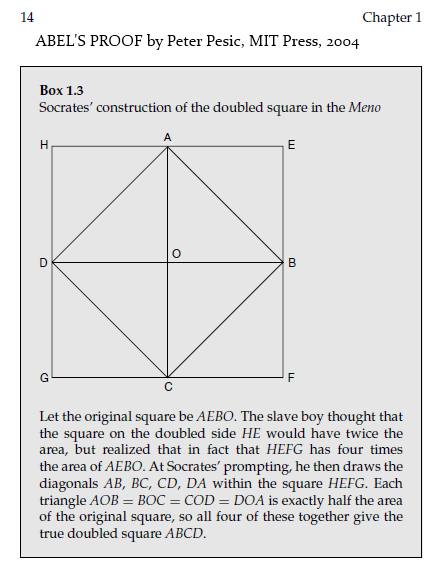
Plato's Diamond
The above version by Peter Pesic is from Chapter I of his book Abel's Proof , titled "The Scandal of the Irrational." Plato's diamond also occurs in a much later mathematical story that might be called "The Scandal of the Noncontinuous." The story—
Paradigms"These passages suggest that the Form is a character or set of characters common to a number of things, i.e. the feature in reality which corresponds to a general word. But Plato also uses language which suggests not only that the forms exist separately (χωριστά ) from all the particulars, but also that each form is a peculiarly accurate or good particular of its own kind, i.e. the standard particular of the kind in question or the model (παράδειγμα ) [i.e. paradigm ] to which other particulars approximate…. … Both in the Republic and in the Sophist there is a strong suggestion that correct thinking is following out the connexions between Forms. The model is mathematical thinking, e.g. the proof given in the Meno that the square on the diagonal is double the original square in area." – William and Martha Kneale, The Development of Logic , Oxford University Press paperback, 1985 Plato's paradigm in the Meno—
Changed paradigm in the diamond theorem (2×2 case) —
Aspects of the paradigm change— Monochrome figures to Areas to Continuous transformations to Euclidean geometry to Euclidean quantities to The 24 patterns resulting from the paradigm change—
Each pattern has some ordinary or color-interchange symmetry. This is the 2×2 case of a more general result. The patterns become more interesting in the 4×4 case. For their relationship to finite geometry and finite fields, see the diamond theorem. |
Related material: Plato's Diamond by Oslo artist Josefine Lyche.
“Plato’s Ghost evokes Yeats’s lament that any claim to worldly perfection inevitably is proven wrong by the philosopher’s ghost….”
— Princeton University Press on Plato’s Ghost: The Modernist Transformation of Mathematics (by Jeremy Gray, September 2008)
"Remember me to her."
— Closing words of the Algis Budrys novel Rogue Moon .
Background— Some posts in this journal related to Abel or to random thoughts from his birthday.
Friday, March 18, 2011
Defining Configurations*
The On-Line Encyclopedia of Integer Sequences has an article titled "Number of combinatorial configurations of type (n_3)," by N.J.A. Sloane and D. Glynn.
From that article:
- DEFINITION: A combinatorial configuration of type (n_3) consists of an (abstract) set of n points together with a set of n triples of points, called lines, such that each point belongs to 3 lines and each line contains 3 points.
- EXAMPLE: The unique (8_3) configuration consists of the triples 125, 148, 167, 236, 278, 347, 358, 456.
The following corrects the word "unique" in the example.

* This post corrects an earlier post, also numbered 14660 and dated 7 PM March 18, 2011, that was in error.
The correction was made at about 11:50 AM on March 20, 2011.
_____________________________________________________________
Update of March 21
The problem here is of course with the definition. Sloane and Glynn failed to include in their definition a condition that is common in other definitions of configurations, even abstract or purely "combinatorial" configurations. See, for instance, Configurations of Points and Lines , by Branko Grunbaum (American Mathematical Society, 2009), p. 17—
In the most general sense we shall consider combinatorial (or abstract) configurations; we shall use the term set-configurations as well. In this setting "points" are interpreted as any symbols (usually letters or integers), and "lines" are families of such symbols; "incidence" means that a "point" is an element of a "line". It follows that combinatorial configurations are special kinds of general incidence structures. Occasionally, in order to simplify and clarify the language, for "points" we shall use the term marks, and for "lines" we shall use blocks. The main property of geometric configurations that is preserved in the generalization to set-configurations (and that characterizes such configurations) is that two marks are incident with at most one block, and two blocks with at most one mark.
Whether or not omitting this "at most one" condition from the definition is aesthetically the best choice, it dramatically changes the number of configurations in the resulting theory, as the above (8_3) examples show.
Update of March 22 (itself updated on March 25)
For further background on configurations, see Dolgachev—

Note that the two examples Dolgachev mentions here, with 16 points and 9 points, are not unrelated to the geometry of 4×4 and 3×3 square arrays. For the Kummer and related 16-point configurations, see section 10.3, "The Three Biplanes of Order 4," in Burkard Polster's A Geometrical Picture Book (Springer, 1998). See also the 4×4 array described by Gordon Royle in an undated web page and in 1980 by Assmus and Sardi. For the Hesse configuration, see (for instance) the passage from Coxeter quoted in Quaternions in an Affine Galois Plane.
Update of March 27
See the above link to the (16,6) 4×4 array and the (16,6) exercises using this array in R.D. Carmichael's classic Introduction to the Theory of Groups of Finite Order (1937), pp. 42-43. For a connection of this sort of 4×4 geometry to the geometry of the diamond theorem, read "The 2-subsets of a 6-set are the points of a PG(3,2)" (a note from 1986) in light of R.W.H.T. Hudson's 1905 classic Kummer's Quartic Surface , pages 8-9, 16-17, 44-45, 76-77, 78-79, and 80.
Thursday, February 17, 2011
The Form, the Pattern
"… Only by the form, the pattern,
Can words or music reach
The stillness…."
— T. S. Eliot,
Four Quartets

For further details, see Time Fold.
Saturday, January 22, 2011
High School Squares*
The following is from the weblog of a high school mathematics teacher—

This is related to the structure of the figure on the cover of the 1976 monograph Diamond Theory—

Each small square pattern on the cover is a Latin square,
with elements that are geometric figures rather than letters or numerals.
All order-four Latin squares are represented.
For a deeper look at the structure of such squares, let the high-school
chart above be labeled with the letters A through X, and apply the
four-color decomposition theorem. The result is 24 structural diagrams—
Some of the squares are structurally congruent under the group of 8 symmetries of the square.
This can be seen in the following regrouping—
(Image corrected on Jan. 25, 2011– "seven" replaced "eight.")
* Retitled "The Order-4 (i.e., 4×4) Latin Squares" in the copy at finitegeometry.org/sc.
Saturday, June 19, 2010
Imago Creationis
In the above view, four of the tesseract's 16
vertices are overlaid by other vertices.
For views that are more complete and
moveable, see Smith's tesseract page.
Four-Part Tesseract Divisions—

The above figure shows how four-part partitions
of the 16 vertices of a tesseract in an infinite
Euclidean space are related to four-part partitions
of the 16 points in a finite Galois space
|
Euclidean spaces versus Galois spaces in a larger context— Infinite versus Finite The central aim of Western religion —
"Each of us has something to offer the Creator...
the bridging of
masculine and feminine,
life and death.
It's redemption.... nothing else matters."
-- Martha Cooley in The Archivist (1998)
The central aim of Western philosophy —
Dualities of Pythagoras
as reconstructed by Aristotle:
Limited Unlimited
Odd Even
Male Female
Light Dark
Straight Curved
... and so on ....
"Of these dualities, the first is the most important; all the others may be seen as different aspects of this fundamental dichotomy. To establish a rational and consistent relationship between the limited [man, etc.] and the unlimited [the cosmos, etc.] is… the central aim of all Western philosophy." |
Another picture related to philosophy and religion—
Jung's Four-Diamond Figure from Aion—

This figure was devised by Jung
to represent the Self. Compare the
remarks of Paul Valéry on the Self—
|
Flight from Eden: The Origins of Modern Literary Criticism and Theory, by Steven Cassedy, U. of California Press, 1990, pages 156-157—
Valéry saw the mind as essentially a relational system whose operation he attempted to describe in the language of group mathematics. "Every act of understanding is based on a group," he says (C, 1:331). "My specialty— reducing everything to the study of a system closed on itself and finite" (C, 19: 645). The transformation model came into play, too. At each moment of mental life the mind is like a group, or relational system, but since mental life is continuous over time, one "group" undergoes a "transformation" and becomes a different group in the next moment. If the mind is constantly being transformed, how do we account for the continuity of the self? Simple; by invoking the notion of the invariant. And so we find passages like this one: "The S[elf] is invariant, origin, locus or field, it's a functional property of consciousness" (C, 15:170 [2:315]). Just as in transformational geometry, something remains fixed in all the projective transformations of the mind's momentary systems, and that something is the Self (le Moi, or just M, as Valéry notates it so that it will look like an algebraic variable). Transformation theory is all over the place. "Mathematical science… reduced to algebra, that is, to the analysis of the transformations of a purely differential being made up of homogeneous elements, is the most faithful document of the properties of grouping, disjunction, and variation in the mind" (O, 1:36). "Psychology is a theory of transformations, we just need to isolate the invariants and the groups" (C, 1:915). "Man is a system that transforms itself" (C, 2:896). O Paul Valéry, Oeuvres (Paris: Pléiade, 1957-60) C Valéry, Cahiers, 29 vols. (Paris: Centre National de le Recherche Scientifique, 1957-61) |
Note also the remarks of George David Birkhoff at Rice University
in 1940 (pdf) on Galois's theory of groups and the related
"theory of ambiguity" in Galois's testamentary letter—
|
… metaphysical reasoning always relies on the Principle of Sufficient Reason, and… the true meaning of this Principle is to be found in the “Theory of Ambiguity” and in the associated mathematical “Theory of Groups.” If I were a Leibnizian mystic, believing in his “preestablished harmony,” and the “best possible world” so satirized by Voltaire in “Candide,” I would say that the metaphysical importance of the Principle of Sufficient Reason and the cognate Theory of Groups arises from the fact that God thinks multi-dimensionally* whereas men can only think in linear syllogistic series, and the Theory of Groups is the appropriate instrument of thought to remedy our deficiency in this respect. * That is, uses multi-dimensional symbols beyond our grasp. |
Related material:
A medal designed by Leibniz to show how
binary arithmetic mirrors the creation by God
of something (1) from nothing (0).

Another array of 16 strings of 0's and 1's, this time
regarded as coordinates rather than binary numbers—


Some context by a British mathematician —

|
Imago by Wallace Stevens Who can pick up the weight of Britain, Who can move the German load Or say to the French here is France again? Imago. Imago. Imago. It is nothing, no great thing, nor man Of ten brilliancies of battered gold And fortunate stone. It moves its parade Of motions in the mind and heart, A gorgeous fortitude. Medium man In February hears the imagination's hymns And sees its images, its motions And multitudes of motions And feels the imagination's mercies, In a season more than sun and south wind, Something returning from a deeper quarter, A glacier running through delirium, Making this heavy rock a place, Which is not of our lives composed . . . Lightly and lightly, O my land, Move lightly through the air again. |
Wednesday, April 28, 2010
Eightfold Geometry


Related web pages:
Miracle Octad Generator,
Generating the Octad Generator,
Geometry of the 4×4 Square
Related folklore:
"It is commonly known that there is a bijection between the 35 unordered triples of a 7-set [i.e., the 35 partitions of an 8-set into two 4-sets] and the 35 lines of PG(3,2) such that lines intersect if and only if the corresponding triples have exactly one element in common." –"Generalized Polygons and Semipartial Geometries," by F. De Clerck, J. A. Thas, and H. Van Maldeghem, April 1996 minicourse, example 5 on page 6
The Miracle Octad Generator may be regarded as illustrating the folklore.
Update of August 20, 2010–
For facts rather than folklore about the above bijection, see The Moore Correspondence.
Friday, November 6, 2009
Cowboy Song
For a girl I saw once in USA Today in 1995:
in 1995:
Part I:
Top of the online front page, NY Times this morning–


Part II:
Part III:
Adapted song lyrics from “Colorado Trail“–
Kendra was a pretty girl God Almighty knows
Part IV:
Very like another girl 30 years earlier…
Saturday, September 5, 2009
Saturday September 5, 2009
Burning Man

(Cover slightly changed.)
Background —
SAT
Part I:
Part II:
 |
Part III:
From August 25th —

"Boo, boo, boo,
square root of two."
Wednesday, August 12, 2009
Wednesday August 12, 2009
Text:
| The Shining, 1977, page 162: “A new headline, this one “The item on the next page |
Exegesis:
| April 10— Good Friday– See The Paradise of Childhood. Four months later– Aug. 10— “When he thought of the old man |
Monday, June 22, 2009
Monday June 22, 2009
Text
Kris Kristofferson
|
Online Etymology Dictionary
|

"Discuss the geometry
underlying the above picture."
— Log24, June 11, 2009
Thursday, June 11, 2009
Thursday June 11, 2009
Geometry for Jews
(continued from Michelangelo's birthday, 2003)
"Discuss the geometry underlying the above picture."
Abstraction and the Holocaust (Mark Godfrey, Yale University Press, 2007) describes one approach to such a discussion: Bochner "took a photograph of a new arrangement of blocks, cut it up, reprinted it as a negative, and arranged the four corners in every possible configuration using the serial principles of rotation and reversal to make Sixteen Isomorphs (Negative) of 1967, which he later illustrated alongside works by Donald Judd, Sol LeWitt and Eva Hesse in his Artforum article 'The Serial Attitude.' [December 1967, pp. 28-33]" Bochner's picture of "every possible configuration"–
Compare with the 24 figures in Frame Tales
(Log24, Nov. 10, 2008) and in Theme and Variations.
Sunday, May 17, 2009
Sunday May 17, 2009
Laura A. Smit, Calvin College, "Towards an Aesthetic Teleology: Romantic Love, Imagination and the Beautiful in the Thought of Simone Weil and Charles Williams"–
"My work is motivated by a hope that there may be a way to recapture the ancient and medieval vision of both Beauty and purpose in a way which is relevant to our own century. I even dare to hope that the two ideas may be related, that Beauty is actually part of the meaning and purpose of life."
"The Reverend T. P. Kirkman knew in 1862 that there exists a group of degree 16 and order 322560 with a normal, elementary abelian, subgroup of order 16 [1, p. 108]. Frobenius identified this group in 1904 as a subgroup of the Mathieu group M24 [4, p. 570]…."
1. Biggs N.L., "T. P. Kirkman, Mathematician," Bulletin of the London Mathematical Society 13, 97–120 (1981).
4. Frobenius G., "Über die Charaktere der mehrfach transitiven Gruppen," Sitzungsber. Königl. Preuss. Akad. Wiss. zu Berlin, 558–571 (1904). Reprinted in Frobenius, Gesammelte Abhandlungen III (J.-P. Serre, editor), pp. 335–348. Springer, Berlin (1968).
Olli Pottonen, "Classification of Steiner Quadruple Systems" (Master's thesis, Helsinki, 2005)–
"The concept of group actions is very useful in the study of isomorphisms of combinatorial structures."
"Simplify, simplify."
— Thoreau
"Beauty is bound up
with symmetry."
— Weyl
Pottonen's thesis is
dated Nov. 16, 2005.
For some remarks on
images and theology,
see Log24 on that date.
Click on the above image
for some further details.
Tuesday, February 24, 2009
Tuesday February 24, 2009
Meets
Pantheistic Solipsism
Tina Fey to Steve Martin
at the Oscars:
"Oh, Steve, no one wants
to hear about our religion
… that we made up."

|
From Wallace Stevens: A World of Transforming Shapes, by Alan D. Perlis, Bucknell University Press, 1976, p. 117:
… in 'The Pediment of Appearance,' a slight narrative poem in Transport to Summer… A group of young men enter some woods 'Hunting for the great ornament, The pediment of appearance.' Though moving through the natural world, the young men seek the artificial, or pure form, believing that in discovering this pediment, this distillation of the real, they will also discover the 'savage transparence,' the rude source of human life. In Stevens's world, such a search is futile, since it is only through observing nature that one reaches beyond it to pure form. As if to demonstrate the degree to which the young men's search is misaligned, Stevens says of them that 'they go crying/The world is myself, life is myself,' believing that what surrounds them is immaterial. Such a proclamation is a cardinal violation of Stevens's principles of the imagination. |
Superficially the young men's philosophy seems to resemble what Wikipedia calls "pantheistic solipsism"– noting, however, that "This article has multiple issues."
As, indeed, does pantheistic solipsism– a philosophy (properly called "eschatological pantheistic multiple-ego solipsism") devised, with tongue in cheek, by science-fiction writer Robert A. Heinlein.
Despite their preoccupation with solipsism, Heinlein and Stevens point, each in his own poetic way, to a highly non-solipsistic topic from pure mathematics that is, unlike the religion of Martin and Fey, not made up– namely, the properties of space.
"Sharpie, we have condensed six dimensions into four, then we either work by analogy into six, or we have to use math that apparently nobody but Jake and my cousin Ed understands. Unless you can think of some way to project six dimensions into three– you seem to be smart at such projections."
I closed my eyes and thought hard. "Zebbie, I don't think it can be done. Maybe Escher could have done it."
|
A discussion of Stevens's late poem "The Rock" (1954) in Wallace Stevens: A World of Transforming Shapes, by Alan D. Perlis, Bucknell University Press, 1976, p. 120:
For Stevens, the poem "makes meanings of the rock." In the mind, "its barrenness becomes a thousand things/And so exists no more." In fact, in a peculiar irony that only a poet with Stevens's particular notion of the imagination's function could develop, the rock becomes the mind itself, shattered into such diamond-faceted brilliance that it encompasses all possibilities for human thought:
The rock is the gray particular of man's life,
The stone from which he rises, up—and—ho,
The step to the bleaker depths of his descents ...
The rock is the stern particular of the air,
The mirror of the planets, one by one,
But through man's eye, their silent rhapsodist,
Turquoise the rock, at odious evening bright
With redness that sticks fast to evil dreams;
The difficult rightness of half-risen day.
The rock is the habitation of the whole,
Its strength and measure, that which is near,
point A
In a perspective that begins again
At B: the origin of the mango's rind.
(Collected Poems, 528)
|
Stevens's rock is associated with empty space, a concept that suggests "nothingness" to one literary critic:
B. J. Leggett, "Stevens's Late Poetry" in The Cambridge Companion to Wallace Stevens— On the poem "The Rock":
"… the barren rock of the title is Stevens's symbol for the nothingness that underlies all existence, 'That in which space itself is contained'…. Its subject is its speaker's sense of nothingness and his need to be cured of it."
More positively…
Space is, of course, also a topic
in pure mathematics…
For instance, the 6-dimensional
affine space (or the corresponding
5-dimensional projective space)

over the two-element Galois field
can be viewed as an illustration of
Stevens's metaphor in "The Rock."
Cara:

Here the 6-dimensional affine
space contains the 63 points
of PG(5, 2), plus the origin, and
the 3-dimensional affine
space contains as its 8 points
Conwell's eight "heptads," as in
Generating the Octad Generator.
Tuesday, August 19, 2008
Tuesday August 19, 2008
|
"Credences of Summer," VII,
by Wallace Stevens, from
"Three times the concentred |
One possibility —
Bertram Kostant, Professor Emeritus of Mathematics at MIT, on an object discussed in a recent New Yorker:
"A word about E(8). In my opinion, and shared by others, E(8) is the most magnificent 'object' in all of mathematics. It is like a diamond with thousands of facets. Each facet offering a different view of its unbelievable intricate internal structure."
Another possibility —

A more modest object —
the 4×4 square.
Update of Aug. 20-21 —
Kostant's poetic comparison might be applied also to this object.
More precisely, there are 322,560 natural rearrangements– which a poet might call facets*— of the array, each offering a different view of the array's internal structure– encoded as a unique ordered pair of symmetric graphic designs. The symmetry of the array's internal structure is reflected in the symmetry of the graphic designs. For examples, see the Diamond 16 Puzzle.
For an instance of Stevens's "three times" process, see the three parts of the 2004 web page Ideas and Art.
* For the metaphor of rearrangements as facets, note that each symmetry (rearrangement) of a Platonic solid corresponds to a rotated facet: the number of symmetries equals the number of facets times the number of rotations (edges) of each facet–

If Greek geometers had started with a finite space (as in The Eightfold Cube), the history of mathematics might have dramatically illustrated Halmos's saying (Aug. 16) that
"The problem is– the genius is– given an infinite question, to think of the right finite question to ask. Once you thought of the finite answer, then you would know the right answer to the infinite question."
The Greeks, of course, answered the infinite questions first– at least for Euclidean space. Halmos was concerned with more general modern infinite spaces (such as Hilbert space) where the intuition to be gained from finite questions is still of value.
Sunday, August 3, 2008
Sunday August 3, 2008
Geometry
Preview of a Tom Stoppard play presented at Town Hall in Manhattan on March 14, 2008 (Pi Day and Einstein's birthday):
The play's title, "Every Good Boy Deserves Favour," is a mnemonic for the notes of the treble clef EGBDF.
The place, Town Hall, West 43rd Street. The time, 8 p.m., Friday, March 14. One single performance only, to the tinkle– or the clang?– of a triangle. Echoing perhaps the clang-clack of Warsaw Pact tanks muscling into Prague in August 1968.
The “u” in favour is the British way, the Stoppard way, "EGBDF" being "a Play for Actors and Orchestra" by Tom Stoppard (words) and André Previn (music).
And what a play!– as luminescent as always where Stoppard is concerned. The music component of the one-nighter at Town Hall– a showcase for the Boston University College of Fine Arts– is by a 47-piece live orchestra, the significant instrument being, well, a triangle.
When, in 1974, André Previn, then principal conductor of the London Symphony, invited Stoppard "to write something which had the need of a live full-time orchestra onstage," the 36-year-old playwright jumped at the chance.
One hitch: Stoppard at the time knew "very little about 'serious' music… My qualifications for writing about an orchestra," he says in his introduction to the 1978 Grove Press edition of "EGBDF," "amounted to a spell as a triangle player in a kindergarten percussion band."
Review of the same play as presented at Chautauqua Institution on July 24, 2008:
"Stoppard's modus operandi– to teasingly introduce numerous clever tidbits designed to challenge the audience."
— Jane Vranish, Pittsburgh Post-Gazette, Saturday, August 2, 2008
"The leader of the band is tired
And his eyes are growing old
But his blood runs through
My instrument
And his song is in my soul."
— Dan Fogelberg
"He's watching us all the time."
|
Finnegans Wake, Book II, Episode 2, pp. 296-297:
I'll make you to see figuratleavely the whome of your eternal geomater. And if you flung her headdress on her from under her highlows you'd wheeze whyse Salmonson set his seel on a hexengown.1 Hissss!, Arrah, go on! Fin for fun! 1 The chape of Doña Speranza of the Nacion. |
|
Reciprocity From my entry of Sept. 1, 2003:
"…the principle of taking and giving, of learning and teaching, of listening and storytelling, in a word: of reciprocity…. … E. M. Forster famously advised his readers, 'Only connect.' 'Reciprocity' would be Michael Kruger's succinct philosophy, with all that the word implies." — William Boyd, review of Himmelfarb, a novel by Michael Kruger, in The New York Times Book Review, October 30, 1994 Last year's entry on this date:
The picture above is of the complete graph K6 … Six points with an edge connecting every pair of points… Fifteen edges in all. Diamond theory describes how the 15 two-element subsets of a six-element set (represented by edges in the picture above) may be arranged as 15 of the 16 parts of a 4×4 array, and how such an array relates to group-theoretic concepts, including Sylvester's synthematic totals as they relate to constructions of the Mathieu group M24. If diamond theory illustrates any general philosophical principle, it is probably the interplay of opposites…. "Reciprocity" in the sense of Lao Tzu. See Reciprocity and Reversal in Lao Tzu. For a sense of "reciprocity" more closely related to Michael Kruger's alleged philosophy, see the Confucian concept of Shu (Analects 15:23 or 24) described in Kruger's novel is in part about a Jew: the quintessential Jewish symbol, the star of David, embedded in the K6 graph above, expresses the reciprocity of male and female, as my May 2003 archives illustrate. The star of David also appears as part of a graphic design for cubes that illustrate the concepts of diamond theory: Click on the design for details. Those who prefer a Jewish approach to physics can find the star of David, in the form of K6, applied to the sixteen 4×4 Dirac matrices, in
A Graphical Representation The star of David also appears, if only as a heuristic arrangement, in a note that shows generating partitions of the affine group on 64 points arranged in two opposing triplets. Having thus, as the New York Times advises, paid tribute to a Jewish symbol, we may note, in closing, a much more sophisticated and subtle concept of reciprocity due to Euler, Legendre, and Gauss. See |
"Finn MacCool ate the Salmon of Knowledge."
Wikipedia:
"George Salmon spent his boyhood in Cork City, Ireland. His father was a linen merchant. He graduated from Trinity College Dublin at the age of 19 with exceptionally high honours in mathematics. In 1841 at age 21 he was appointed to a position in the mathematics department at Trinity College Dublin. In 1845 he was appointed concurrently to a position in the theology department at Trinity College Dublin, having been confirmed in that year as an Anglican priest."
Related material:
Arrangements for
56 Triangles.
For more on the
arrangement of
triangles discussed
in Finnegans Wake,
see Log24 on Pi Day,
March 14, 2008.
Happy birthday,
Martin Sheen.
Thursday, July 31, 2008
Thursday July 31, 2008
“Put bluntly, who is kidding whom?”
— Anthony Judge, draft of
“Potential Psychosocial Significance
of Monstrous Moonshine:
An Exceptional Form of Symmetry
as a Rosetta Stone for
Cognitive Frameworks,”
dated September 6, 2007.
Good question.
Also from
September 6, 2007 —
the date of
Madeleine L’Engle‘s death —
 |
1. The performance of a work by
Richard Strauss,
“Death and Transfiguration,”
(Tod und Verklärung, Opus 24)
by the Chautauqua Symphony
at Chautauqua Institution on
July 24, 2008
2. Headline of a music review
in today’s New York Times:
Welcoming a Fresh Season of
Transformation and Death
3. The picture of the R. T. Curtis
Miracle Octad Generator
on the cover of the book
Twelve Sporadic Groups:

4. Freeman Dyson’s hope, quoted by
Gorenstein in 1986, Ronan in 2006,
and Judge in 2007, that the Monster
group is “built in some way into
the structure of the universe.”
5. Symmetry from Plato to
the Four-Color Conjecture
7. Yesterday’s entry,
“Theories of Everything“
Coda:

as a tesseract.“
— Madeleine L’Engle
For a profile of
L’Engle, click on
the Easter eggs.
Saturday, July 19, 2008
Saturday July 19, 2008
Bertram Kostant, Professor Emeritus of Mathematics at MIT, on an object discussed in this week's New Yorker:
Hermann Weyl on the hard core of objectivity:
Steven H. Cullinane on the symmetries of a 4×4 array of points:
|
A Structure-Endowed Entity
"A guiding principle in modern mathematics is this lesson: Whenever you have to do with a structure-endowed entity S, try to determine its group of automorphisms, the group of those element-wise transformations which leave all structural relations undisturbed. You can expect to gain a deep insight into the constitution of S in this way." — Hermann Weyl in Symmetry Let us apply Weyl's lesson to the following "structure-endowed entity."
What is the order of the resulting group of automorphisms? |
The above group of
automorphisms plays
a role in what Weyl,
following Eddington,
called a "colorful tale"–

This puzzle shows
that the 4×4 array can
also be viewed in
thousands of ways.
"You can make 322,560
pairs of patterns. Each
pair pictures a different
symmetry of the underlying
16-point space."
— Steven H. Cullinane,
July 17, 2008
For other parts of the tale,
see Ashay Dharwadker,
the Four-Color Theorem,
and Usenet Postings.
Wednesday, June 18, 2008
Wednesday June 18, 2008
| CHANGE FEW CAN BELIEVE IN |
Page 67 —
“… Bill and Violet were married. The wedding was held in the Bowery loft on June 16th, the same day Joyce’s Jewish Ulysses had wandered around Dublin. A few minutes before the exchange of vows, I noted that Violet’s last name, Blom, was only an o away from Bloom, and that meaningless link led me to reflect on Bill’s name, Wechsler, which carries the German root for change, changing, and making change. Blooming and changing, I thought.”
For Hustvedt’s discussion of Wechsler’s art– sculptured cubes, which she calls “tightly orchestrated semantic bombs” (p. 169)– see Log24, May 25, 2008.
(after David Wechsler,
1896-1981, chief
psychologist at Bellevue)
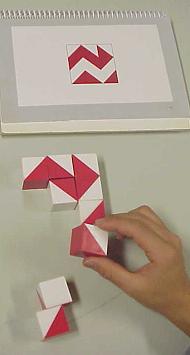
These cubes are used to
make 3×3 patterns for
psychological testing.
Related 3×3 patterns appear
in “nine-patch” quilt blocks
and in the following–
| Don Park at docuverse.com, Jan. 19, 2007: “How to draw an Identicon
A 9-block is a small quilt using only 3 types of patches, out of 16 available, in 9 positions. Using the identicon code, 3 patches are selected: one for center position, one for 4 sides, and one for 4 corners. Positions and Rotations For center position, only a symmetric patch is selected (patch 1, 5, 9, and 16). For corner and side positions, patch is rotated by 90 degree moving clock-wise starting from top-left position and top position respectively.” |
| From a weblog by Scott Sherrill-Mix:
“… Don Park came up with the original idea for representing users with geometric shapes….” Claire | 20-Dec-07 at 9:35 pm | Permalink “This reminds me of a flash demo by Jarred Tarbell |
| Jared Tarbell at levitated.net, May 15, 2002:
“The nine block is a common design pattern among quilters. Its construction methods and primitive building shapes are simple, yet produce millions of interesting variations.  Figure A. Four 9 block patterns,
arbitrarily assembled, show the grid composition of the block. Each block is composed of 9 squares, arranged in a 3 x 3 grid. Each square is composed of one of 16 primitive shapes. Shapes are arranged such that the block is radially symmetric. Color is modified and assigned arbitrarily to each new block.
The basic building blocks of the nine block are limited to 16 unique geometric shapes. Each shape is allowed to rotate in 90 degree increments. Only 4 shapes are allowed in the center position to maintain radial symmetry.
 Figure B. The 16 possible shapes allowed |
Such designs become of mathematical interest when their size is increased slightly, from square arrays of nine blocks to square arrays of sixteen. See Block Designs in Art and Mathematics.
(This entry was suggested by examples of 4×4 Identicons in use at Secret Blogging Seminar.)
Monday, June 16, 2008
Monday June 16, 2008
(American Mathematical Society Feb. 2008
review of Steven Brams’s Superior Beings:
If They Exist, How Would We Know?)
(pdf, 15 megabytes)
"Brams does not attempt to prove or disprove God. He uses elementary ideas from game theory to create situations between a Person (P) and God (Supreme Being, SB) and discusses how each reacts to the other in these model scenarios….
1) P can believe in SB's existence
2) P can not believe in SB's existence
The Supreme Being also has two options:
1) SB can reveal Himself
2) SB can not reveal Himself
Each player also has a primary and secondary goal. For the Person, the primary goal is to have his belief (or non-belief) confirmed by evidence (or lack thereof). The secondary goal is to 'prefer to believe in SB’s existence.' For the Supreme Being, the primary goal is to have P believe in His existence, while the secondary goal is to not reveal Himself. These goals allow us to rank all the outcomes for each player from best (4) to worst (1). We end up with a matrix as follows (the first number in the parentheses represents the SB's ranking for that box; the second number represents P's ranking):

Analogously:
|
Lotteries on Bloomsday, June 16, 2008 |
Pennsylvania (No revelation) |
New York (Revelation) |
|
Mid-day (No belief) |
418
No belief, |
064
Revelation |
|
Evening (Belief) |
709
Belief without |
198
|
The holy image

denoting belief and revelation
may be interpreted as
a black hole or as a
symbol by James Joyce:
|
When? Going to dark bed there was a square round Sinbad the Sailor roc's auk's egg in the night of the bed of all the auks of the rocs of Darkinbad the Brightdayler. Where?
— Ulysses, conclusion of Chapter 17 |






